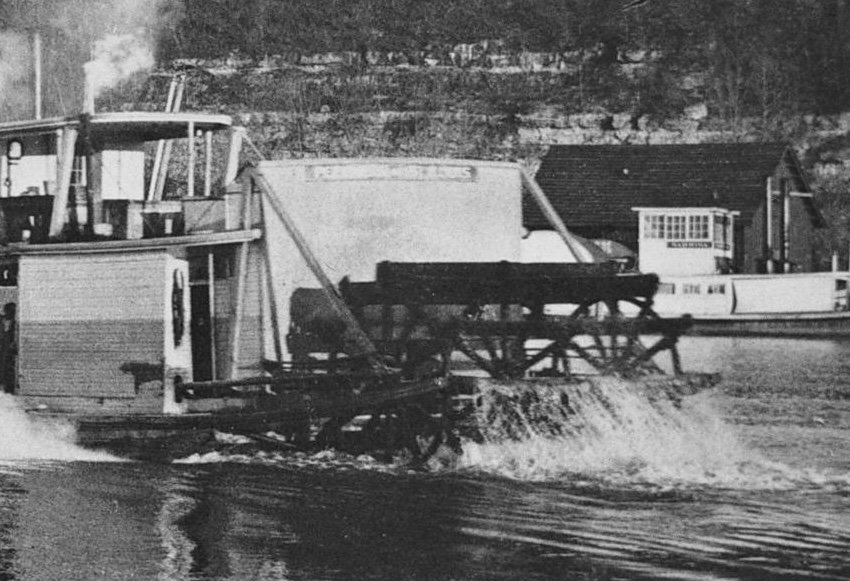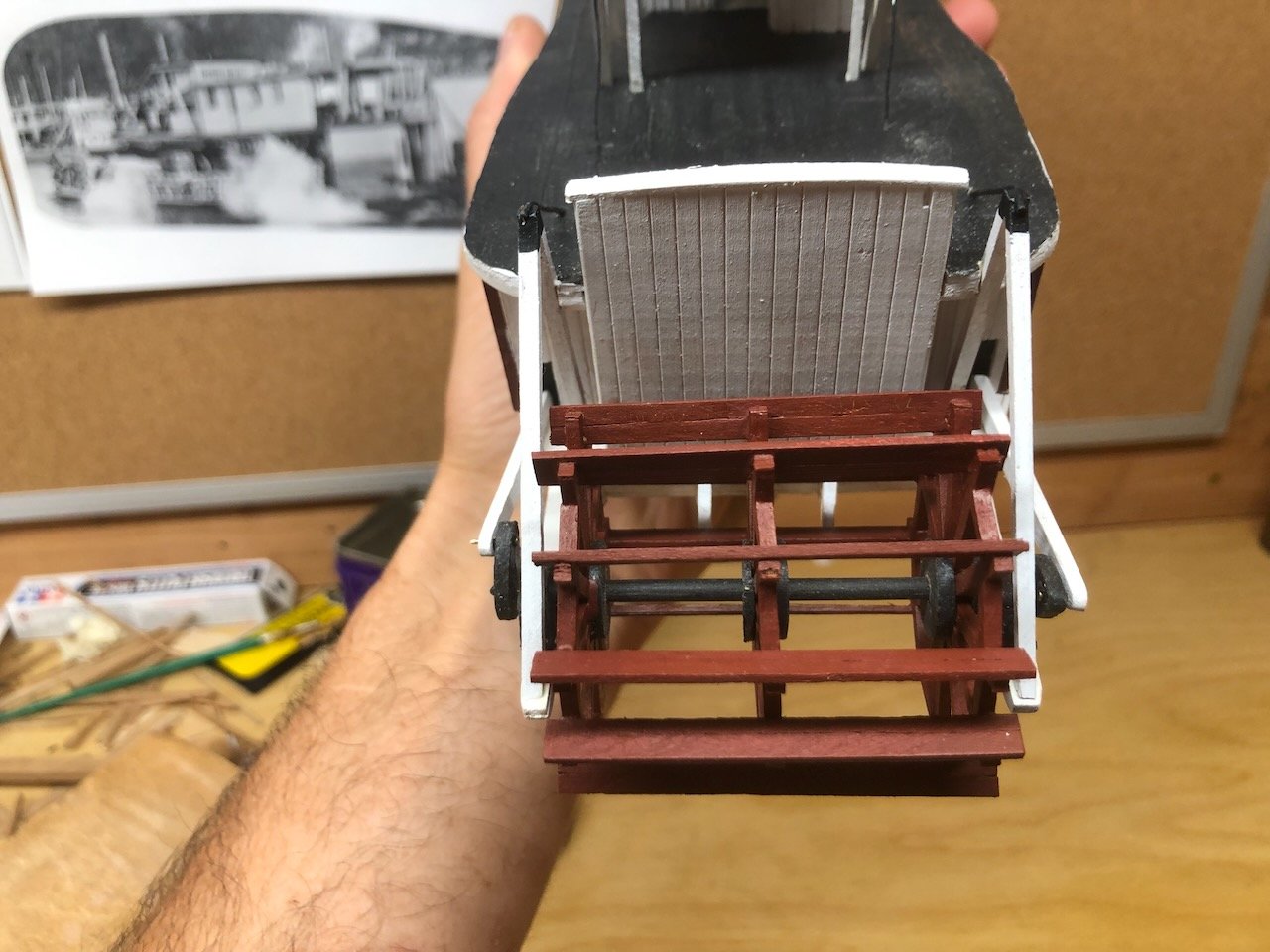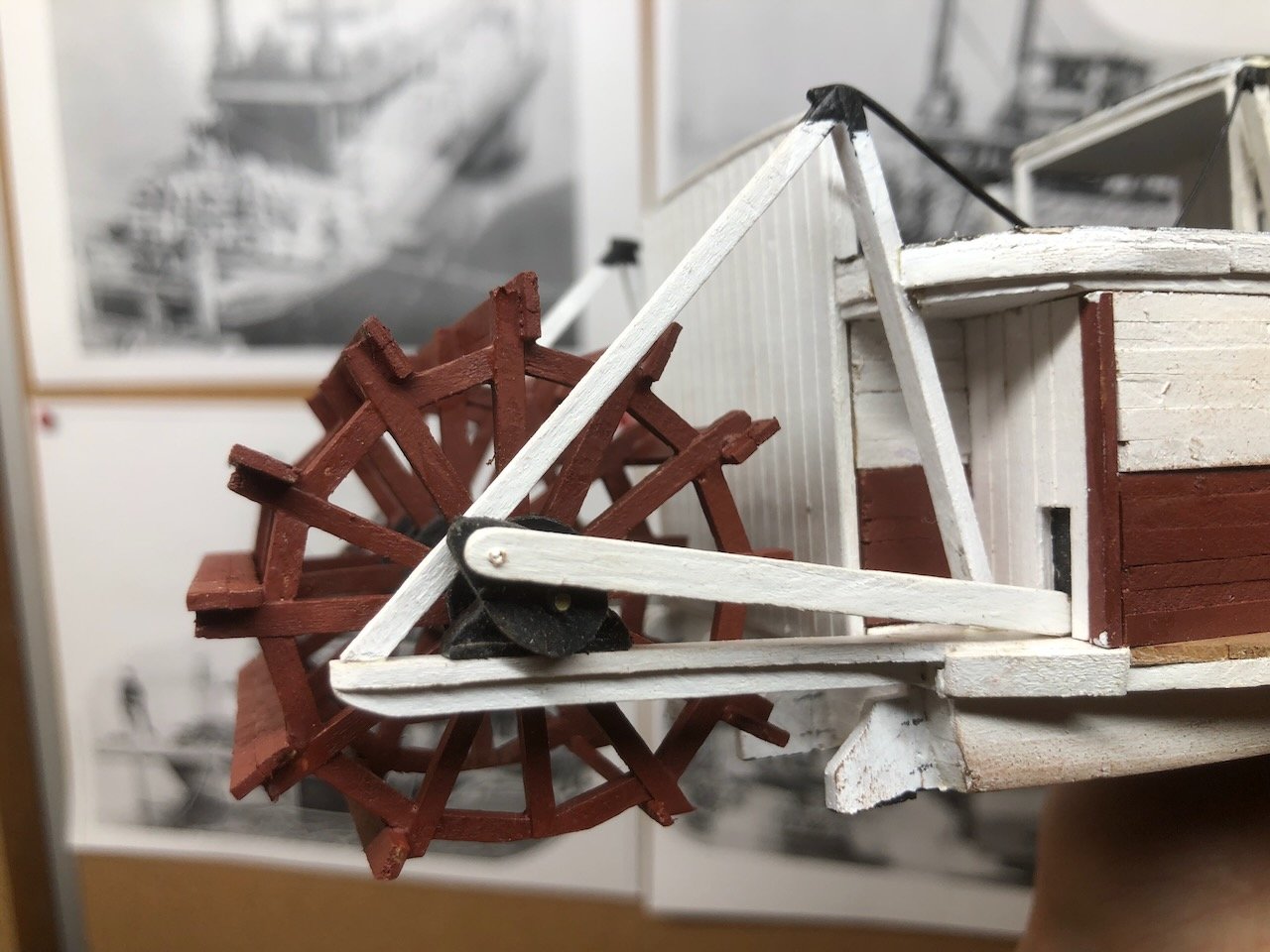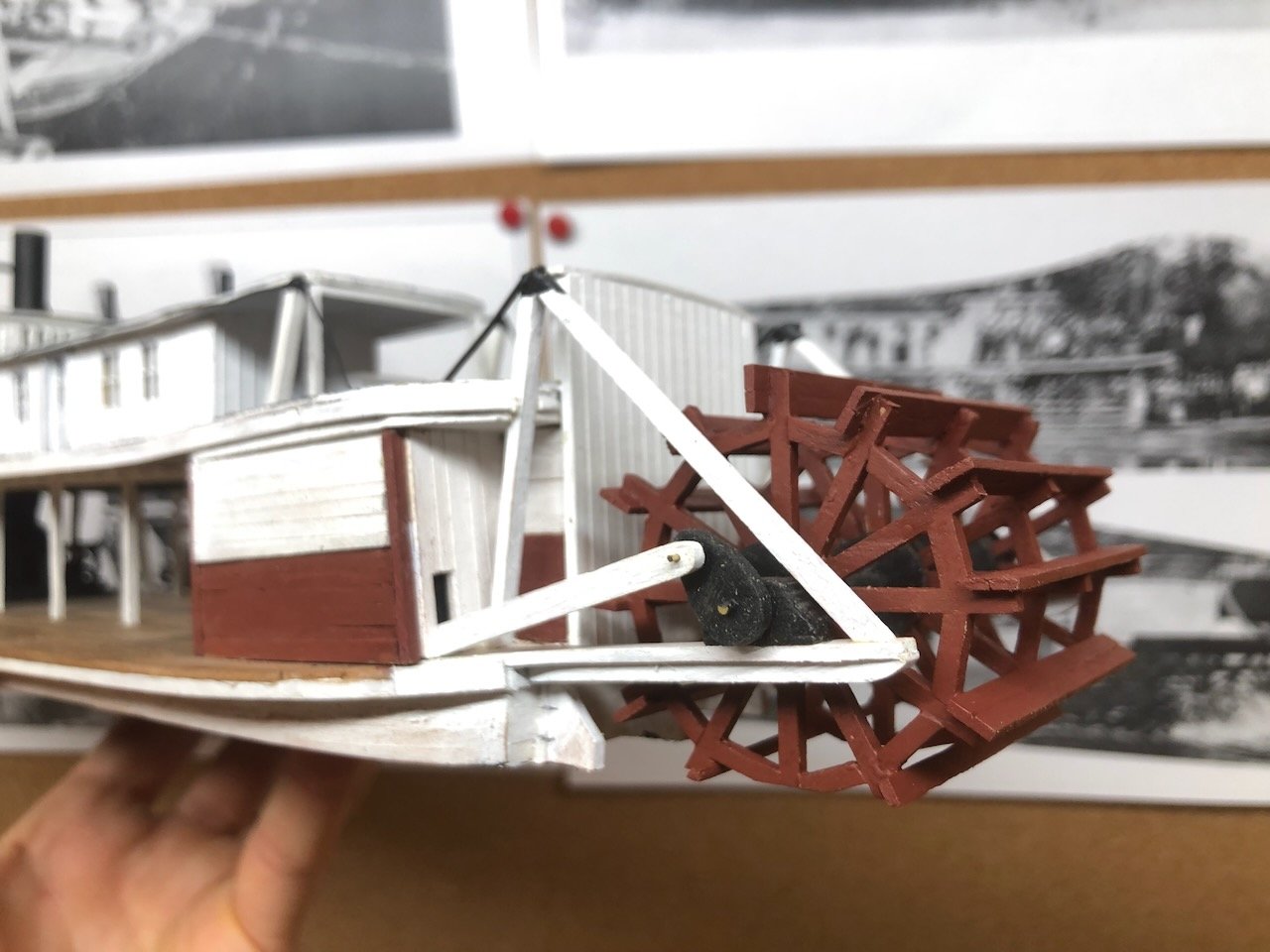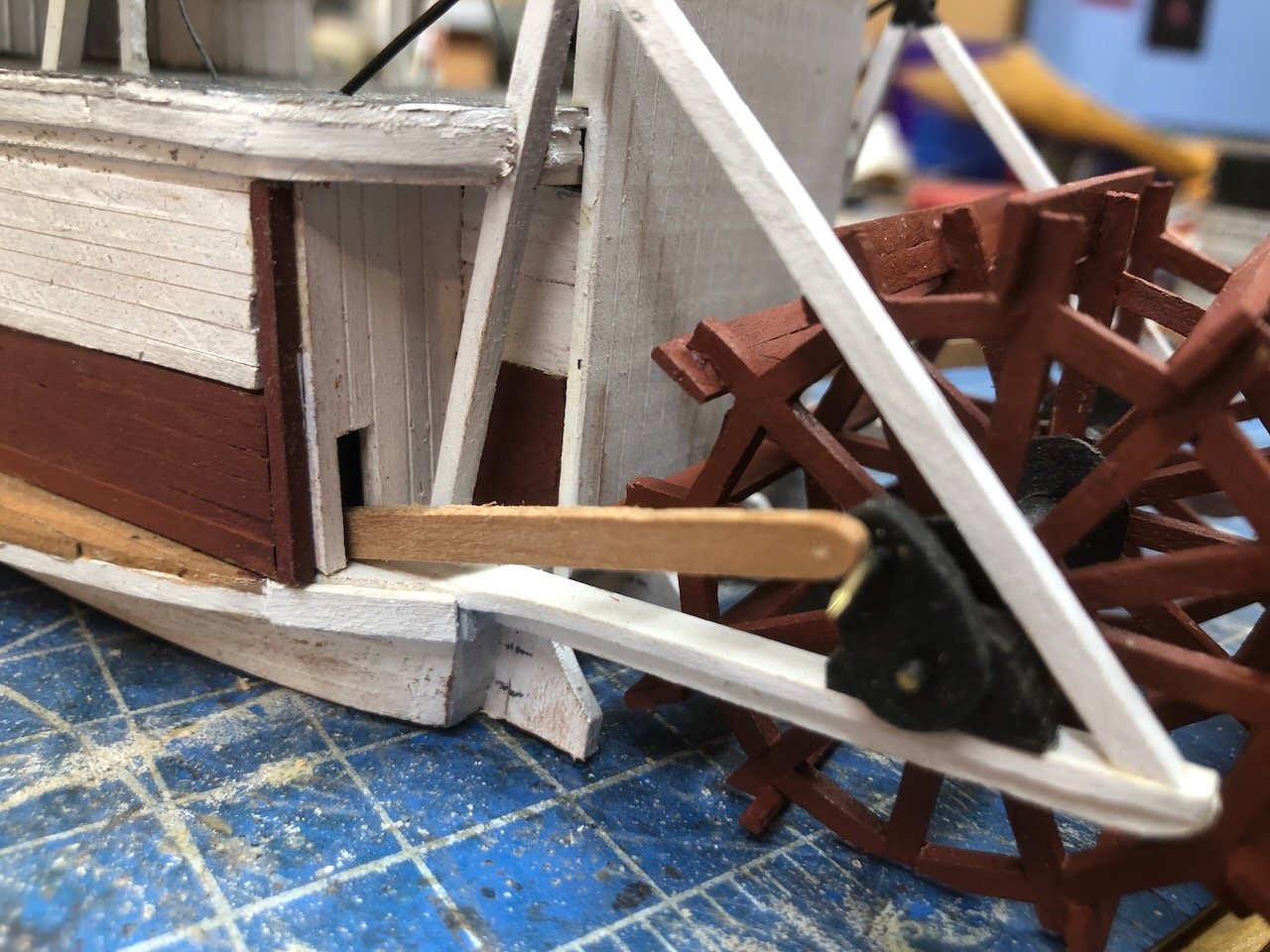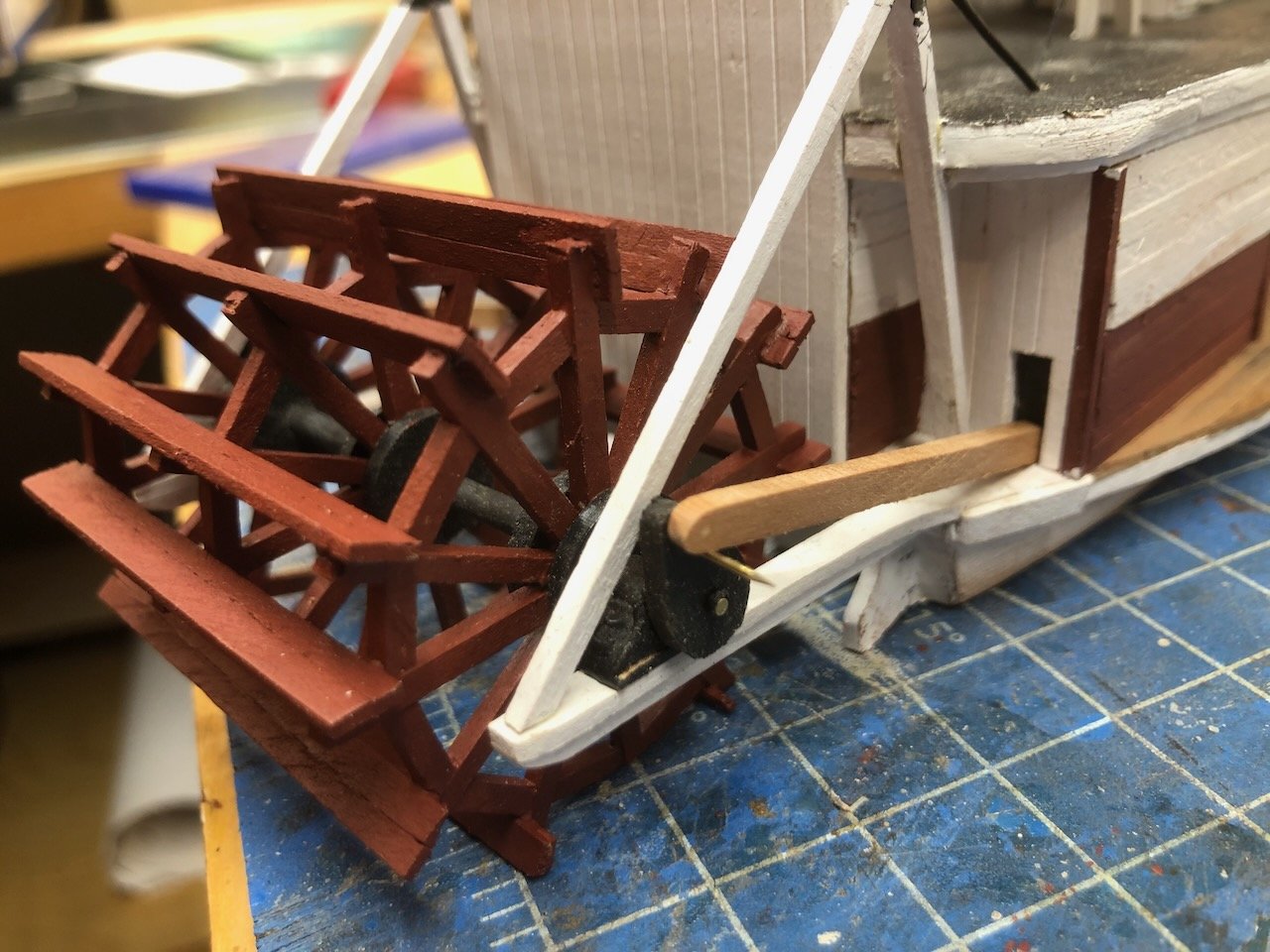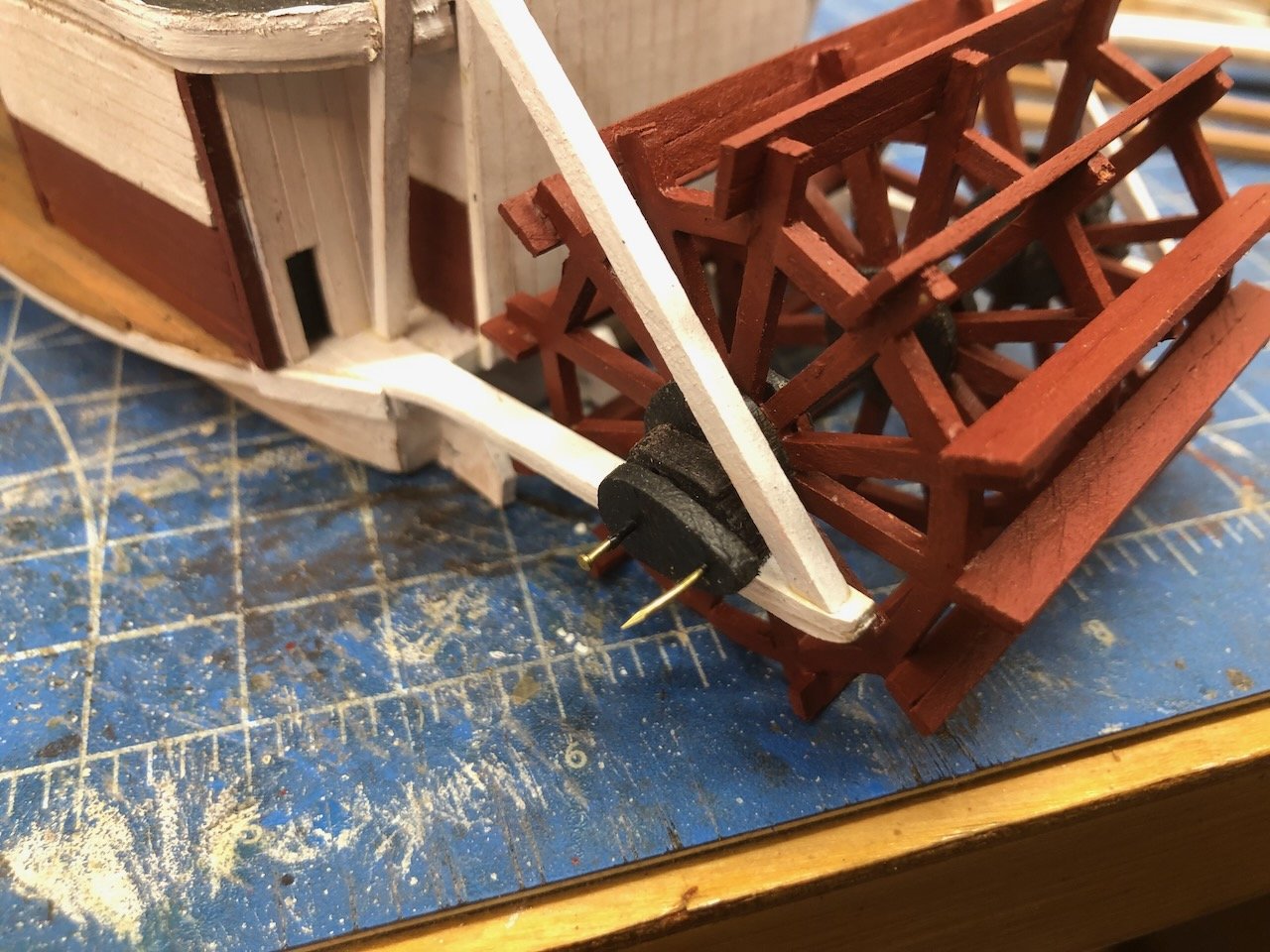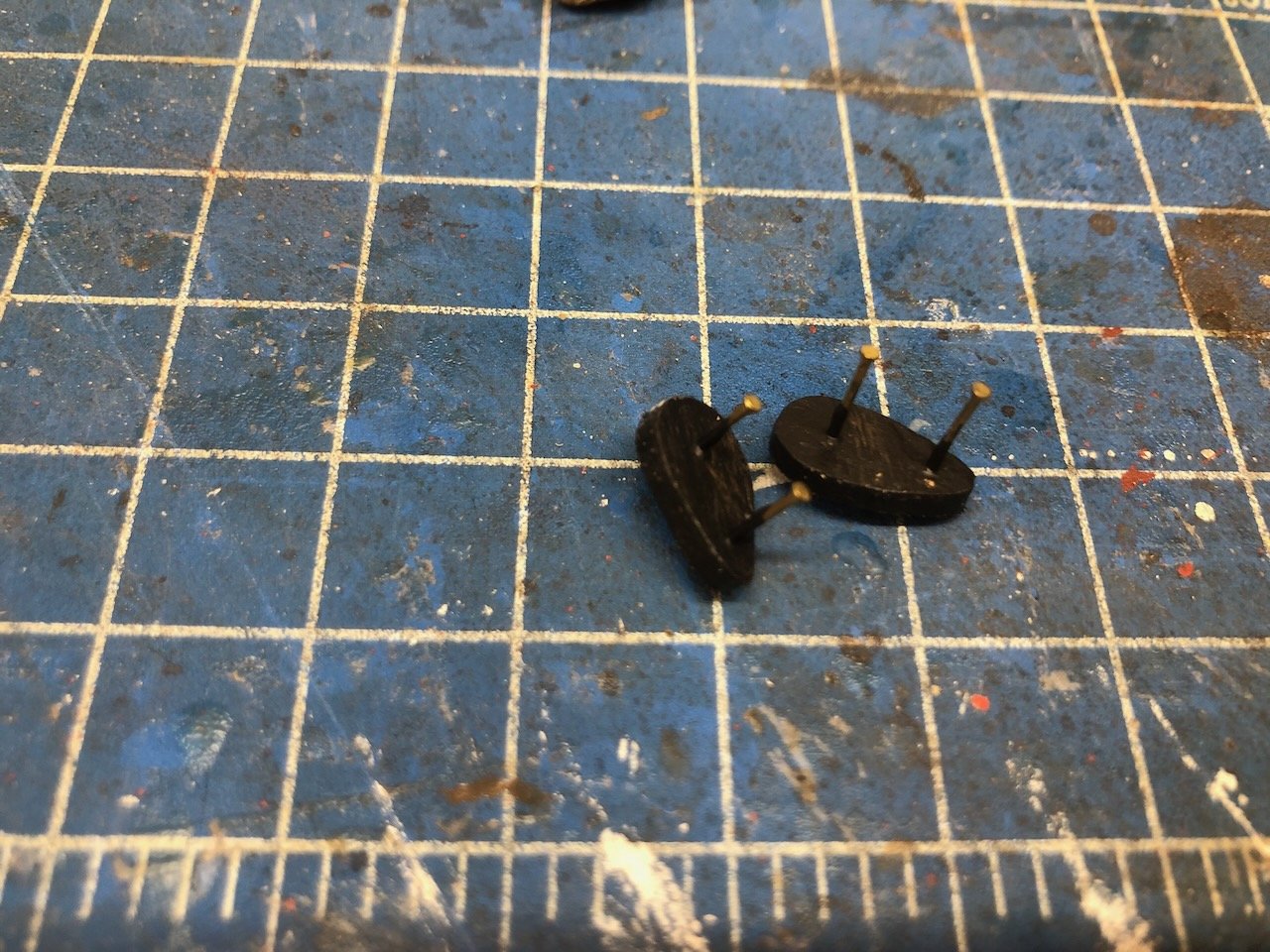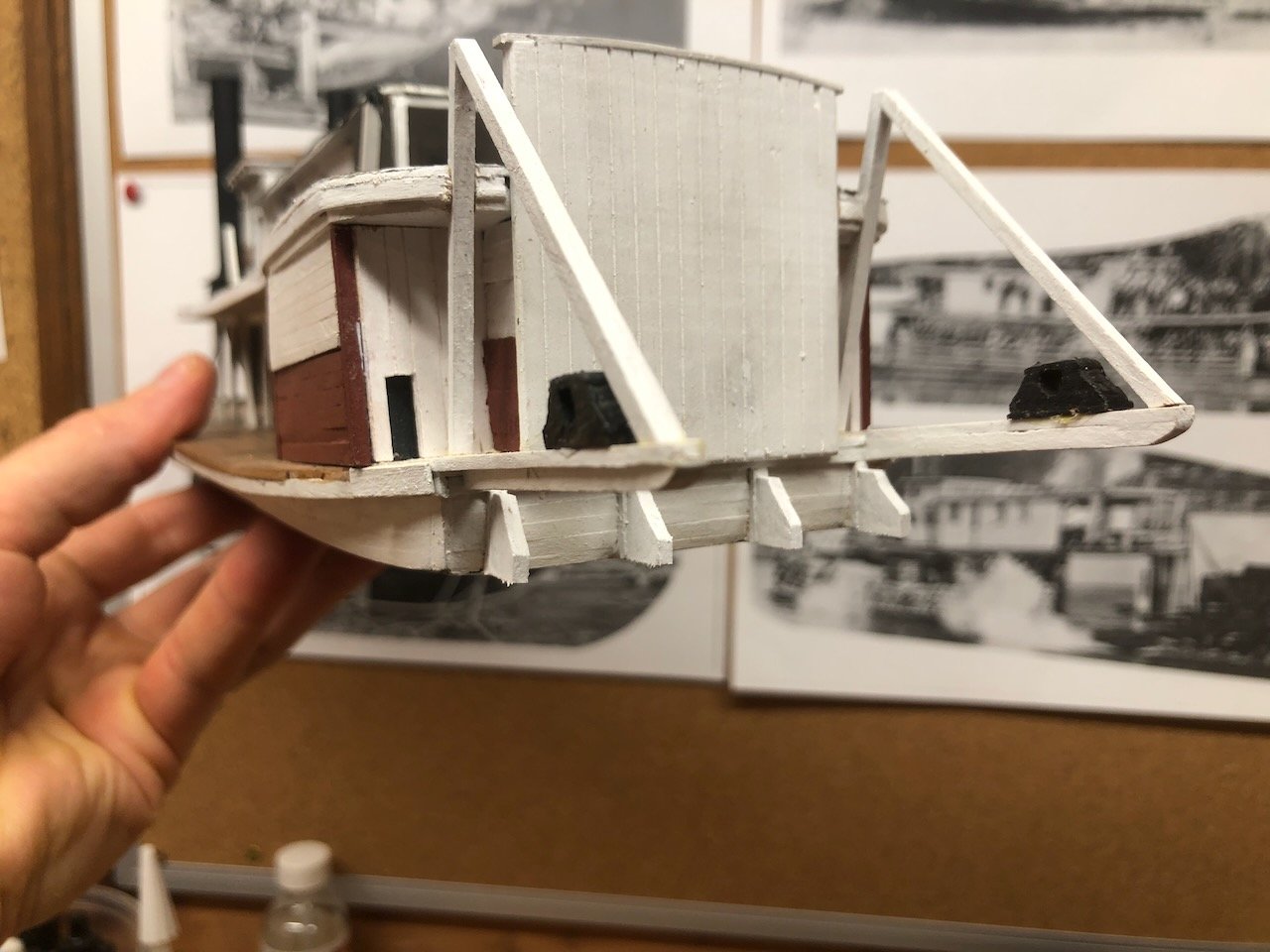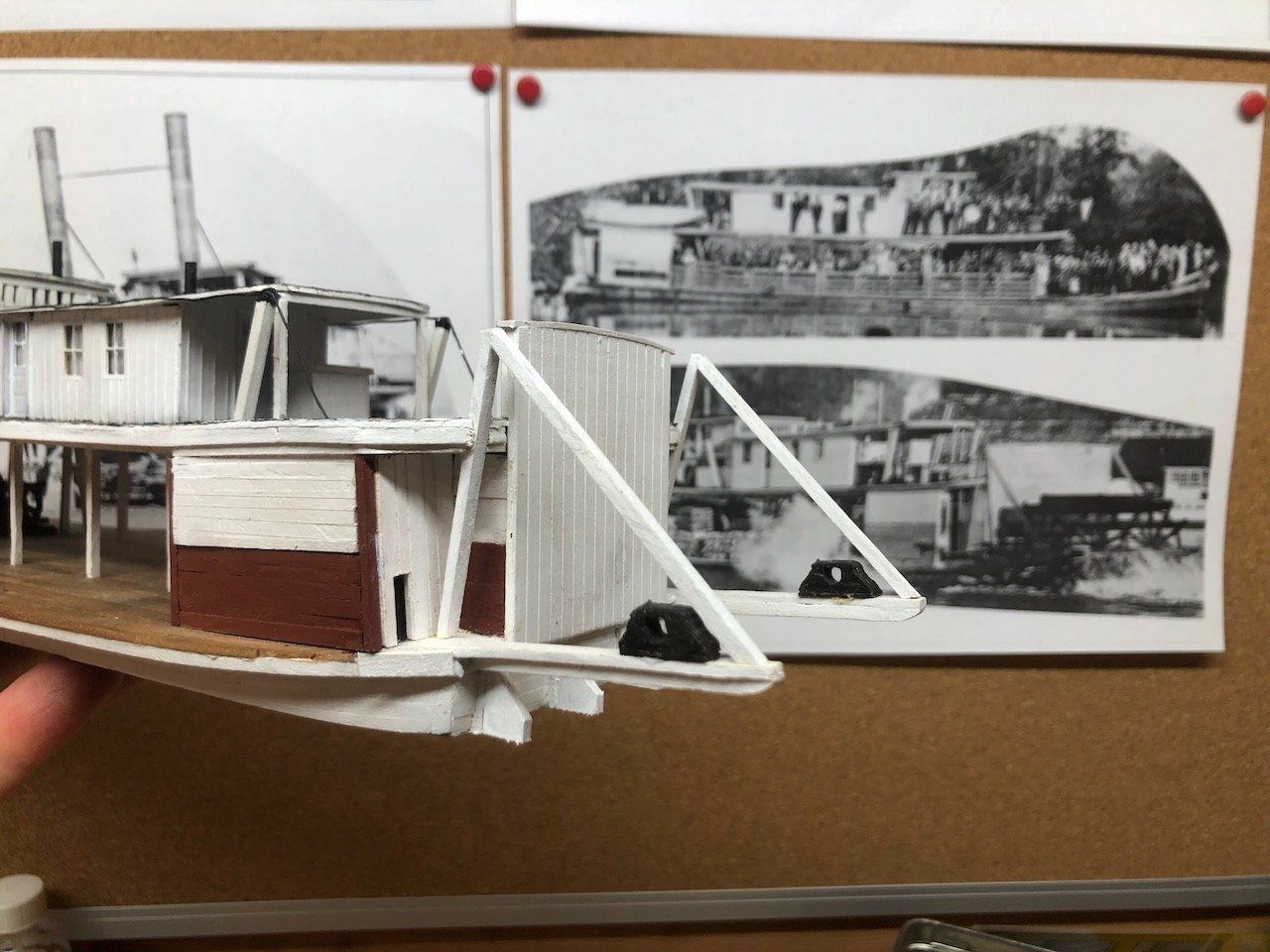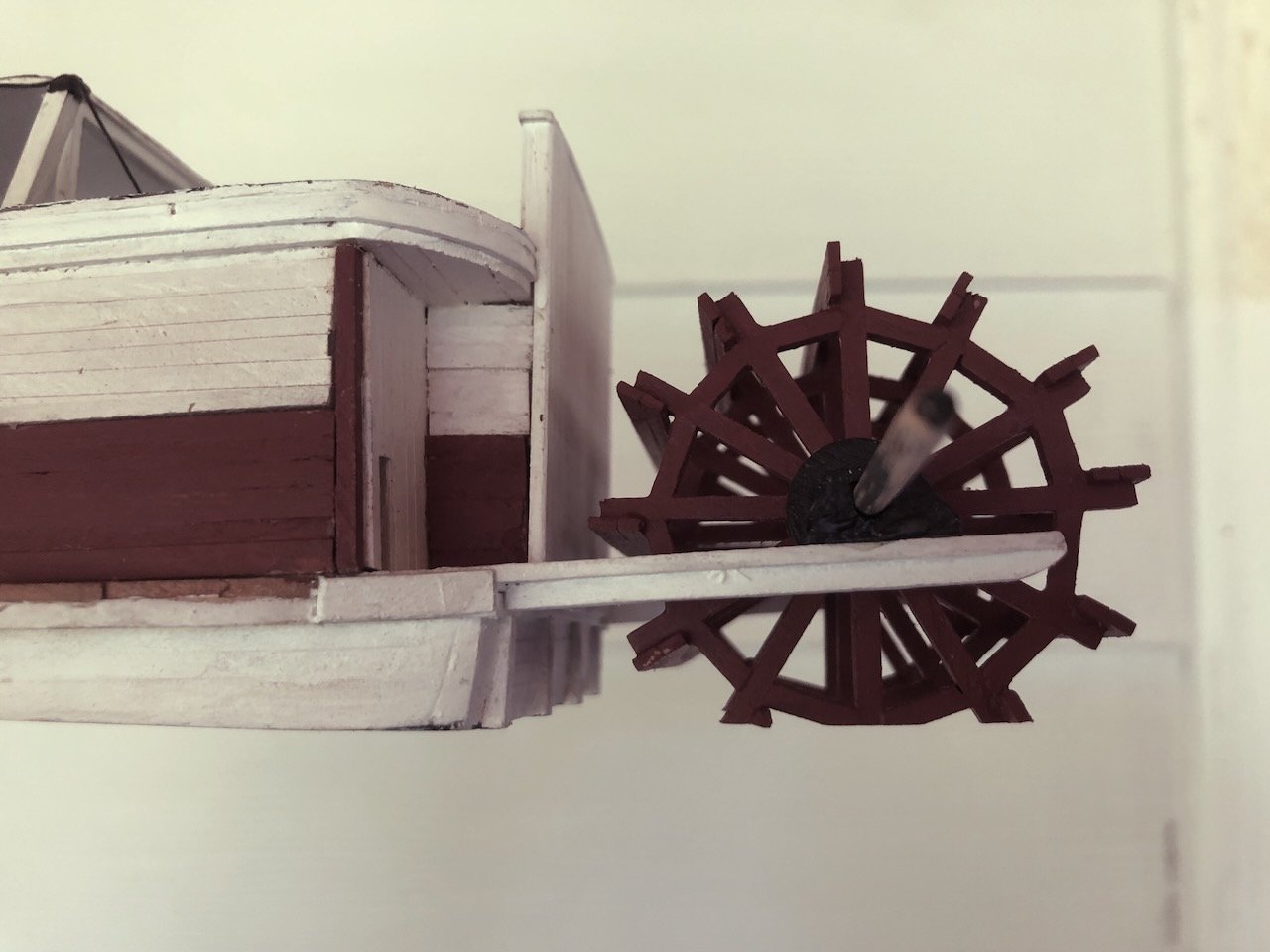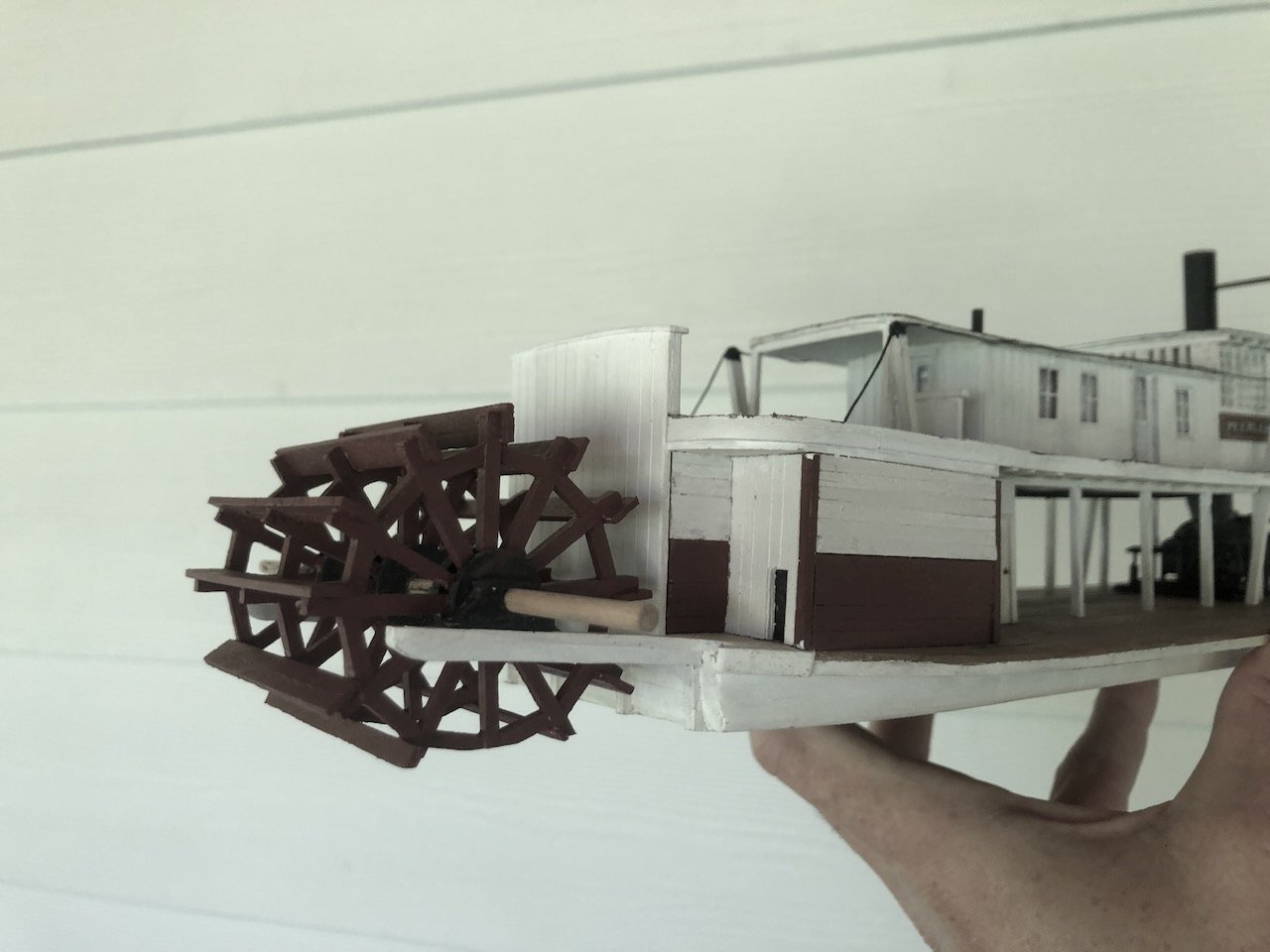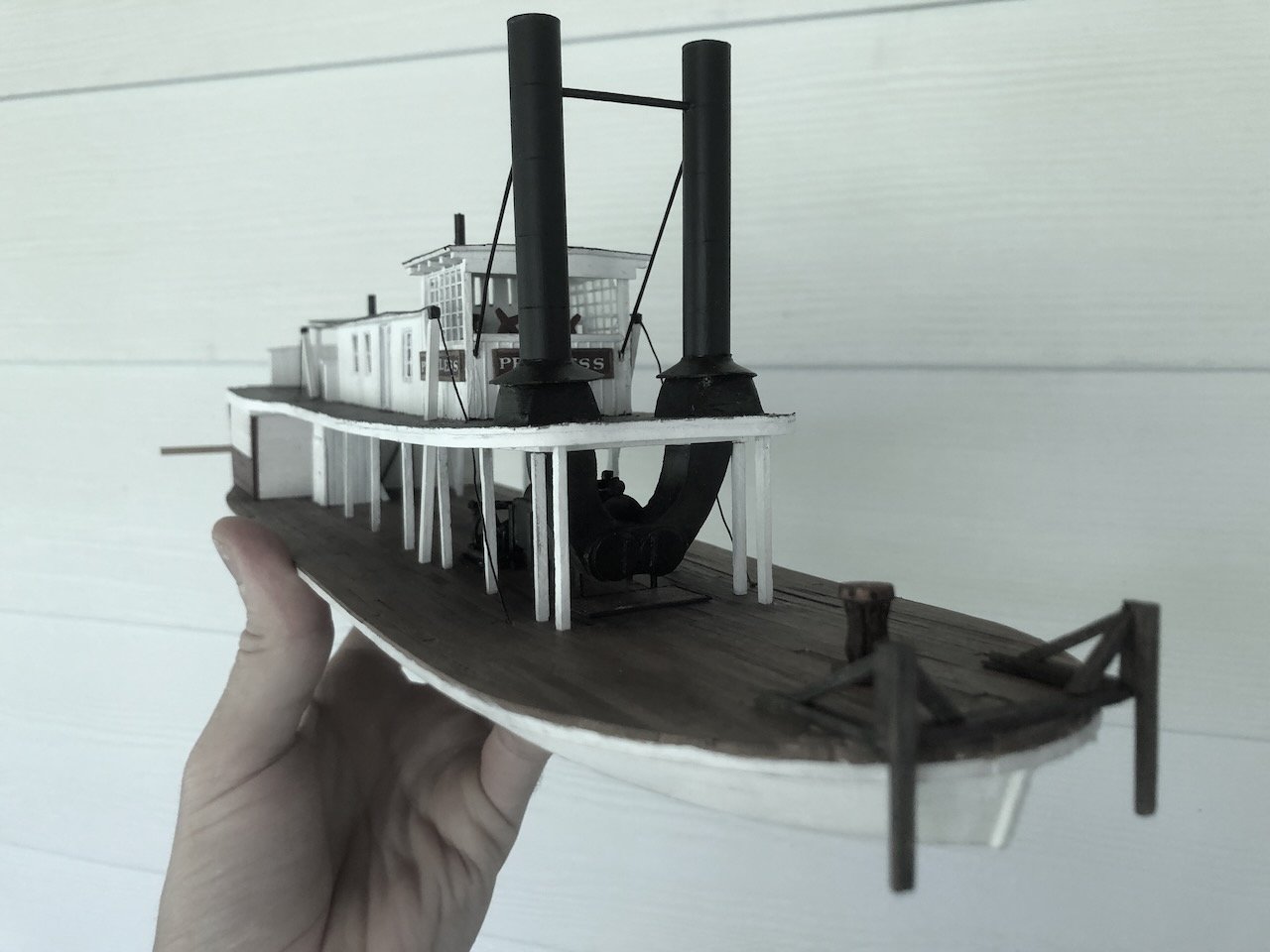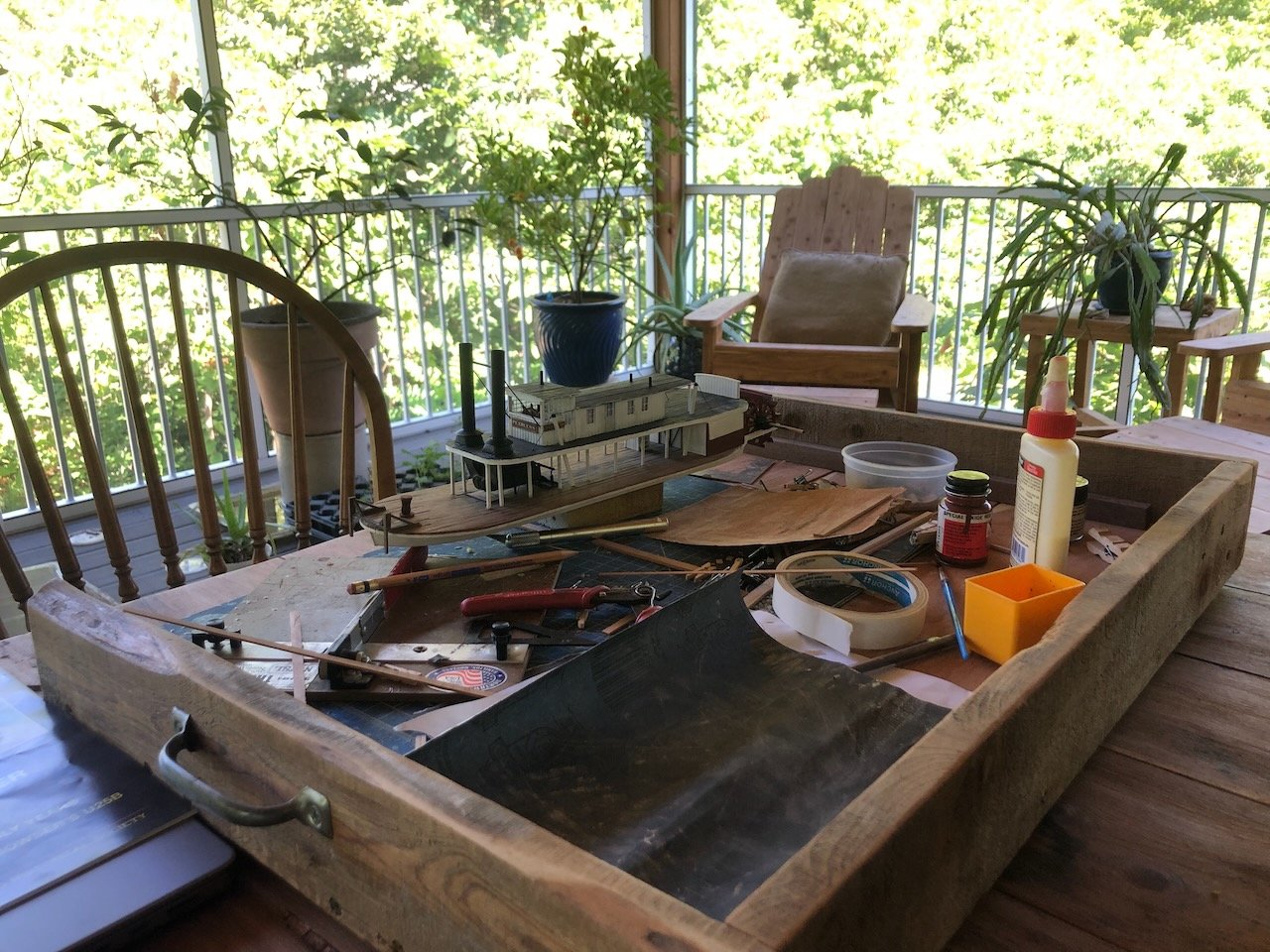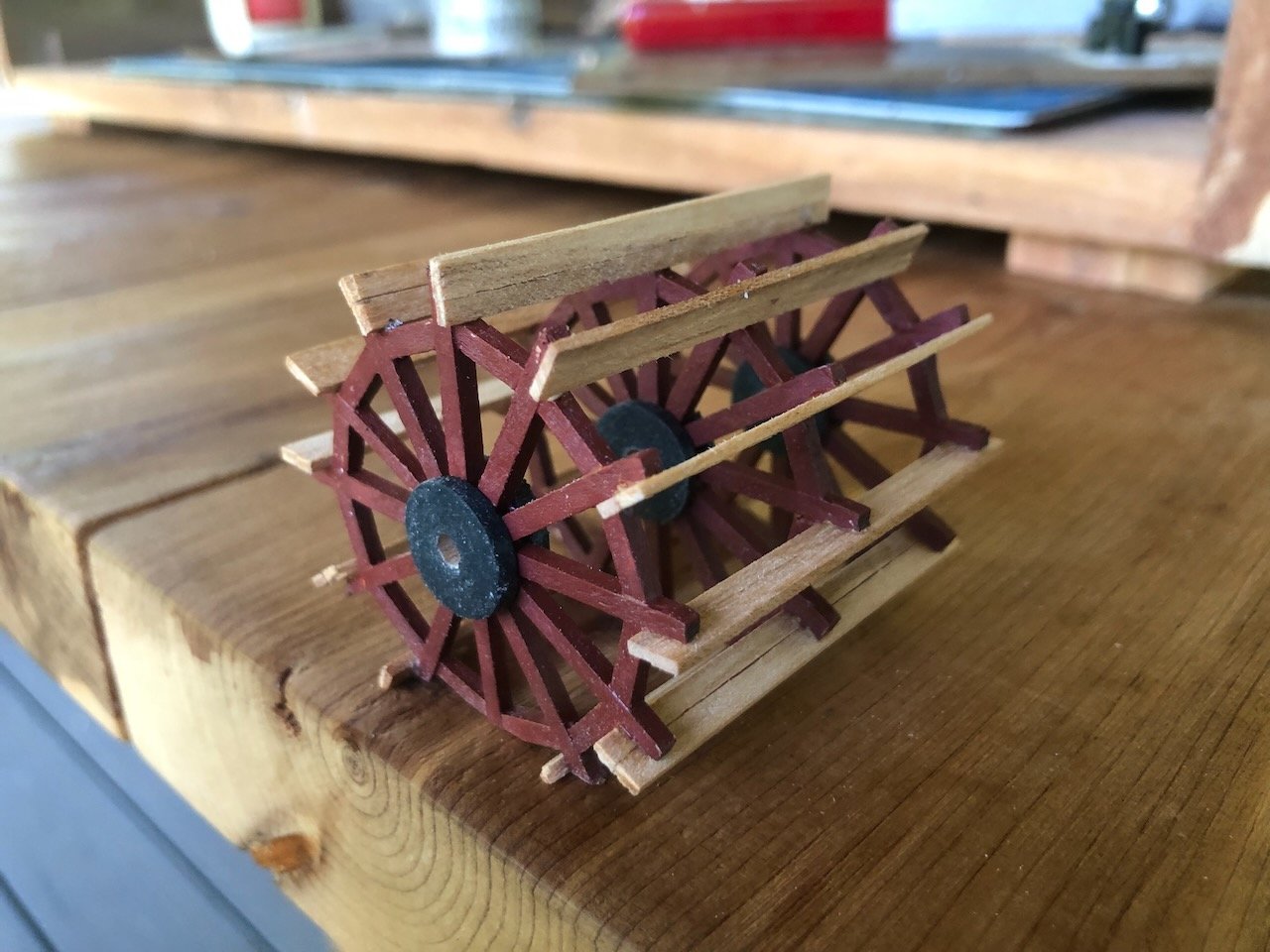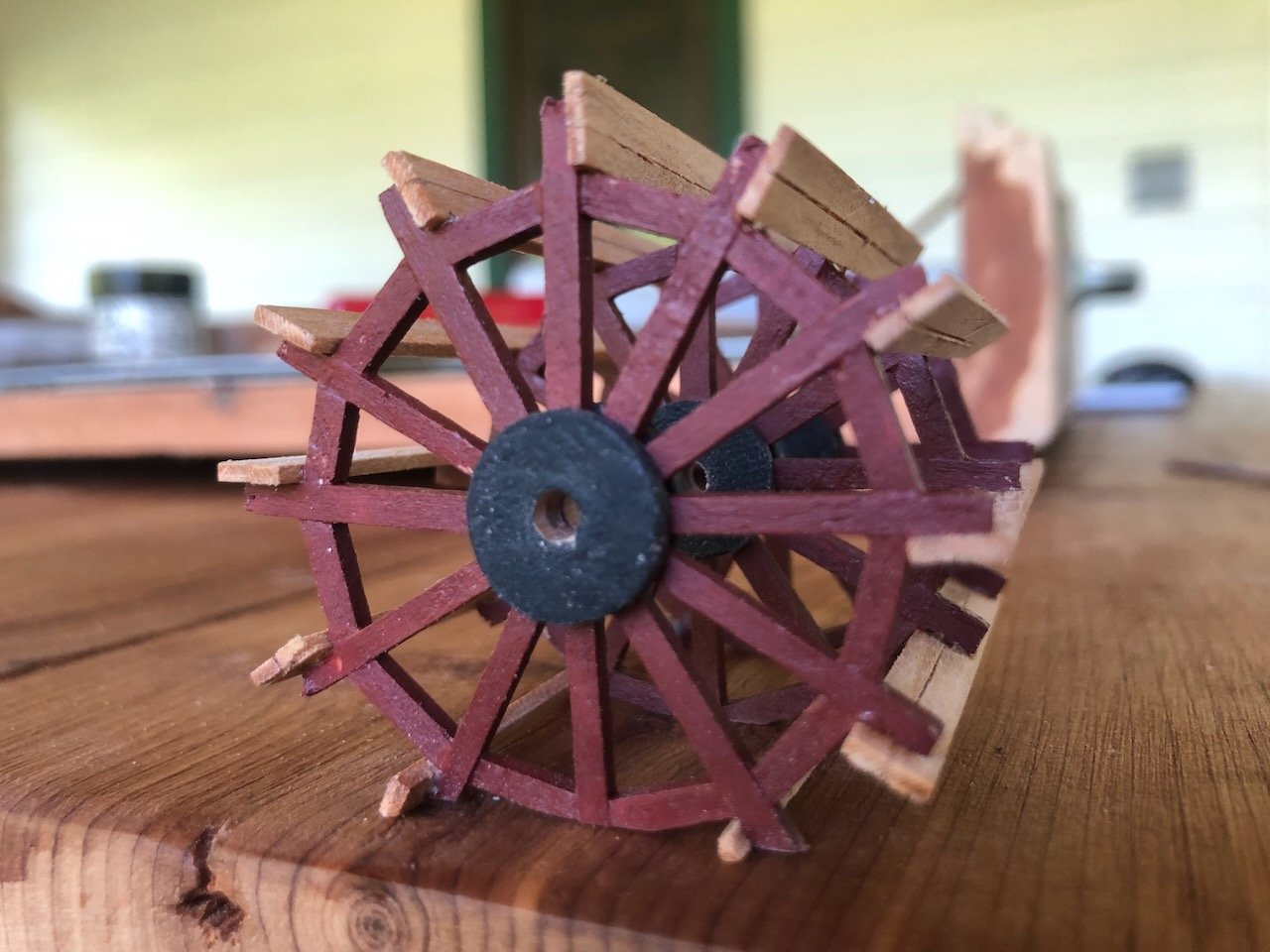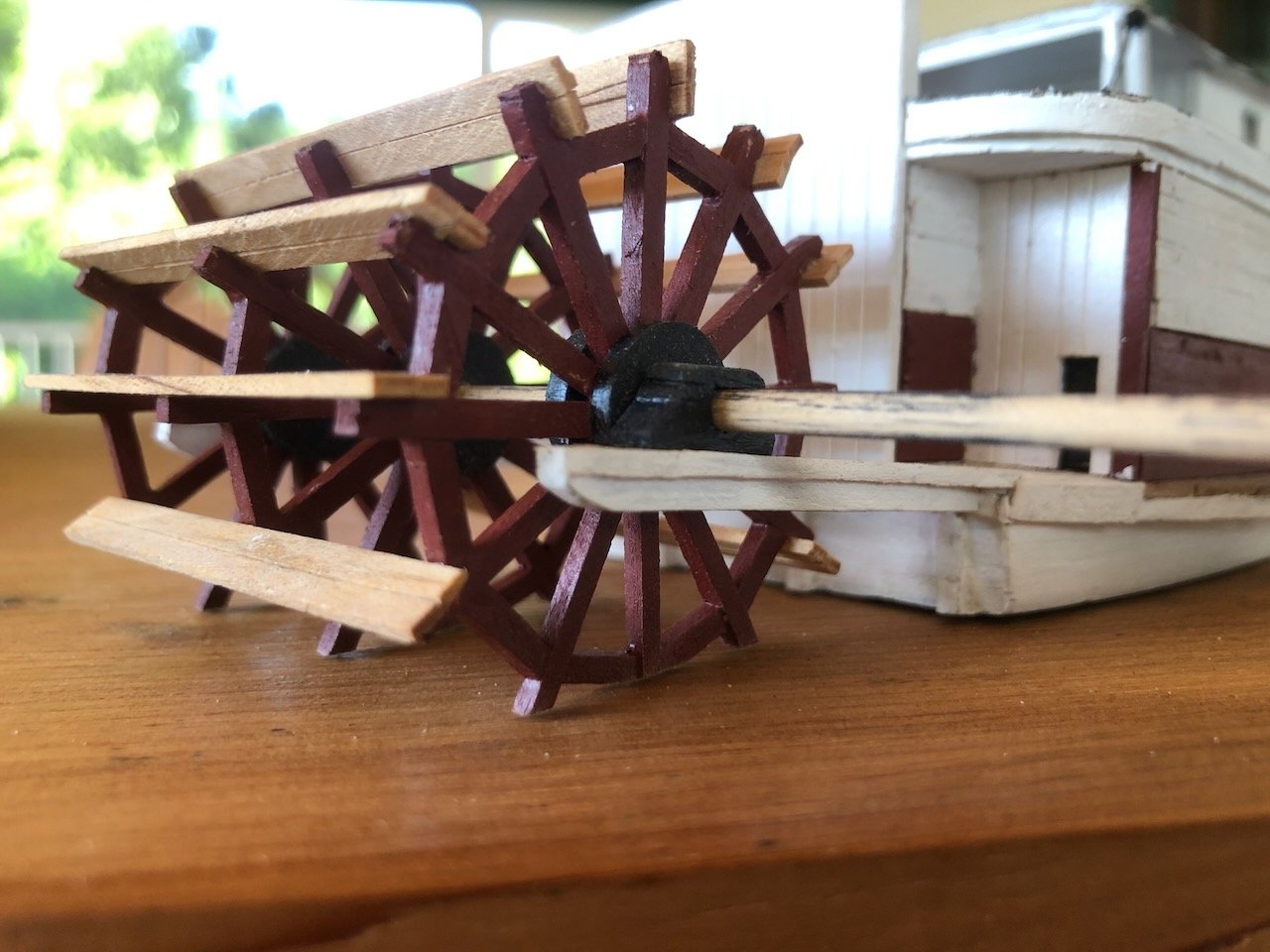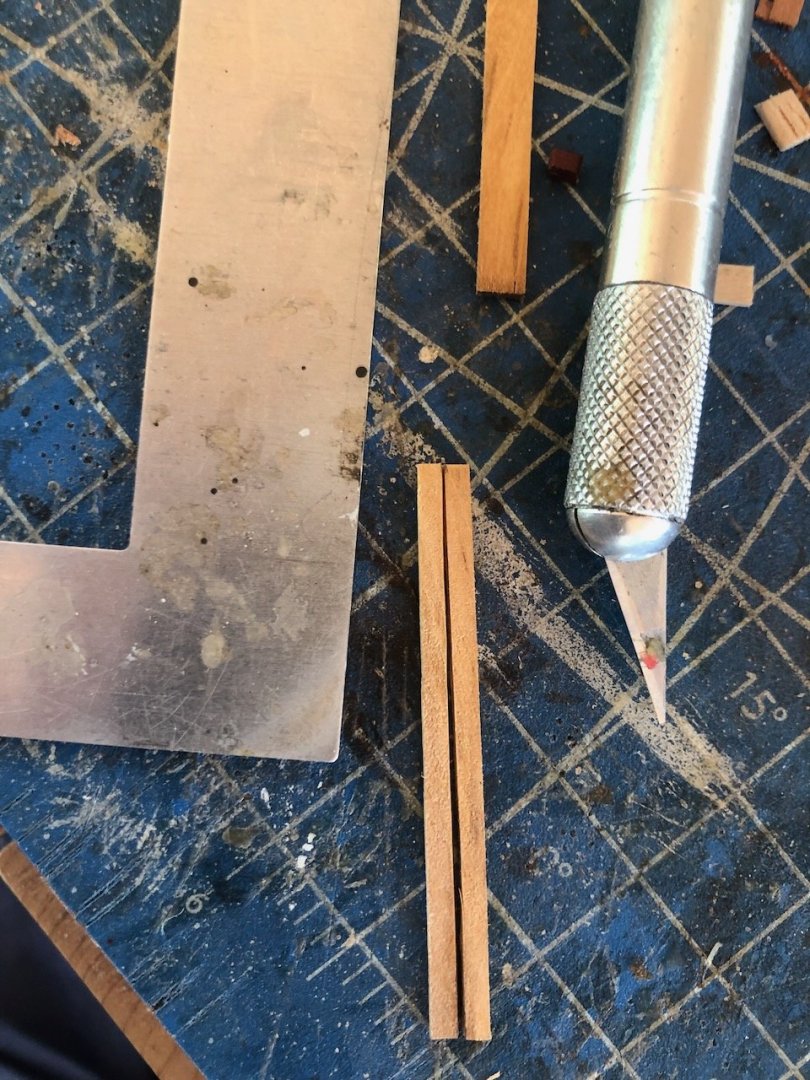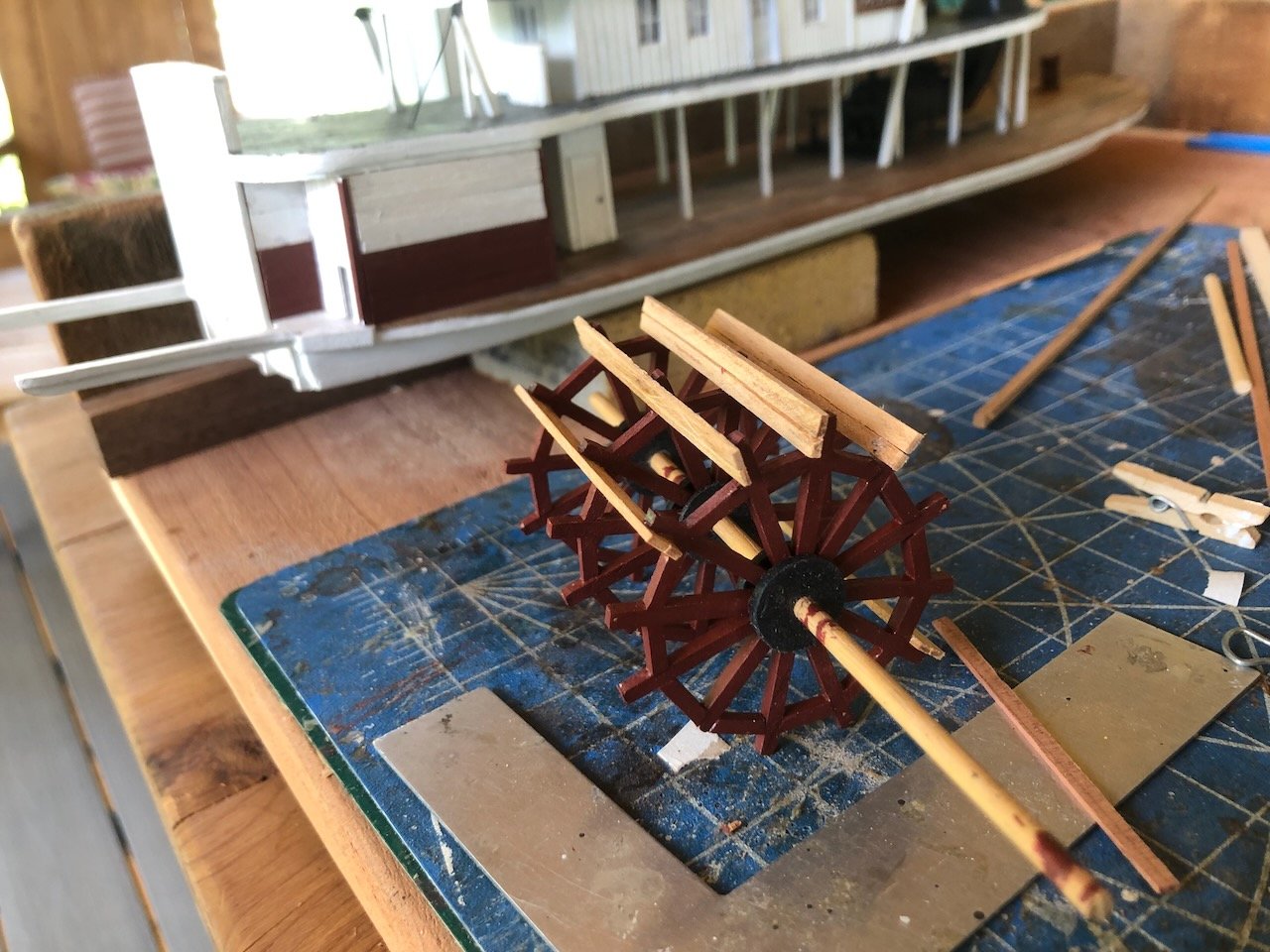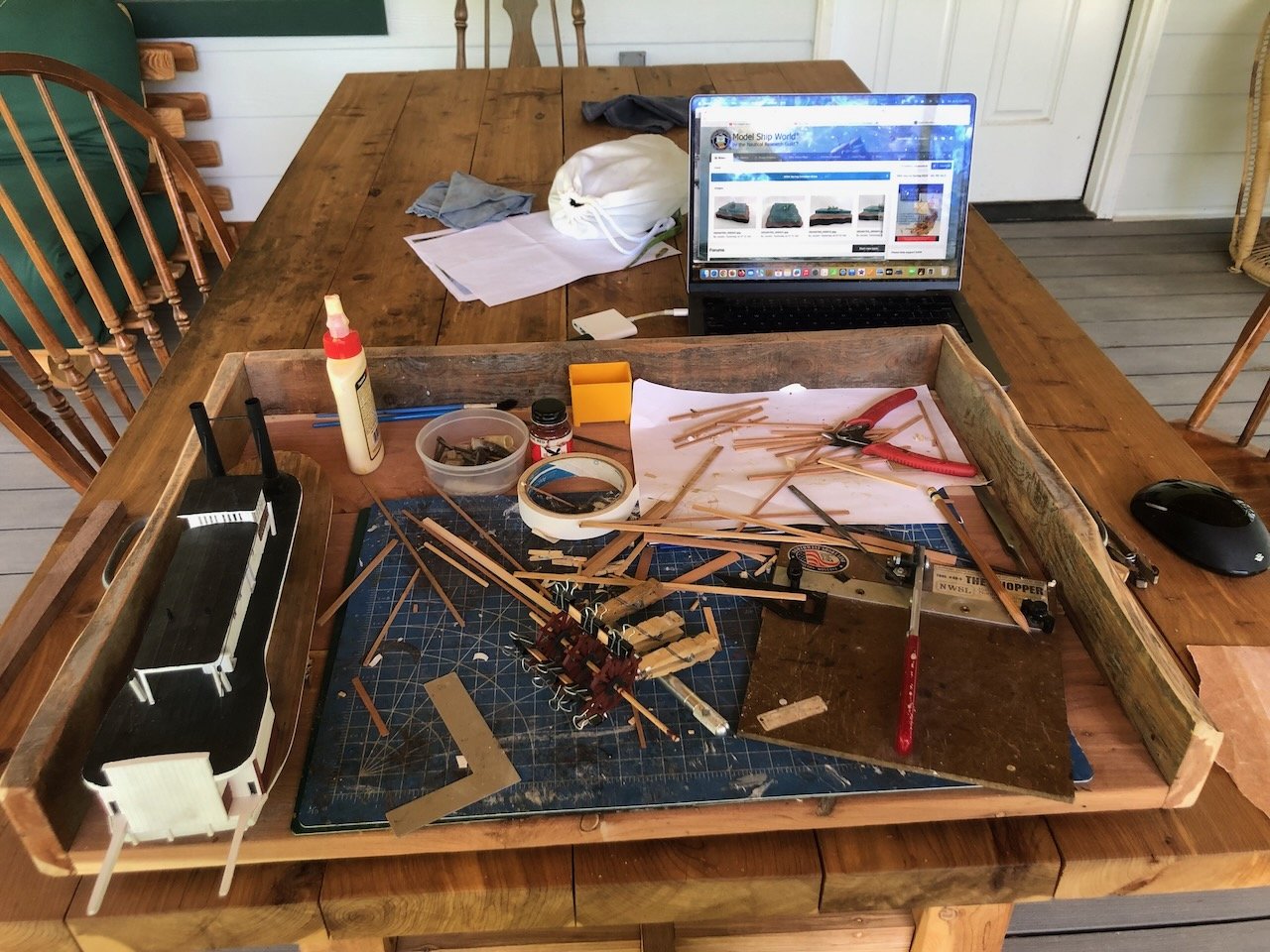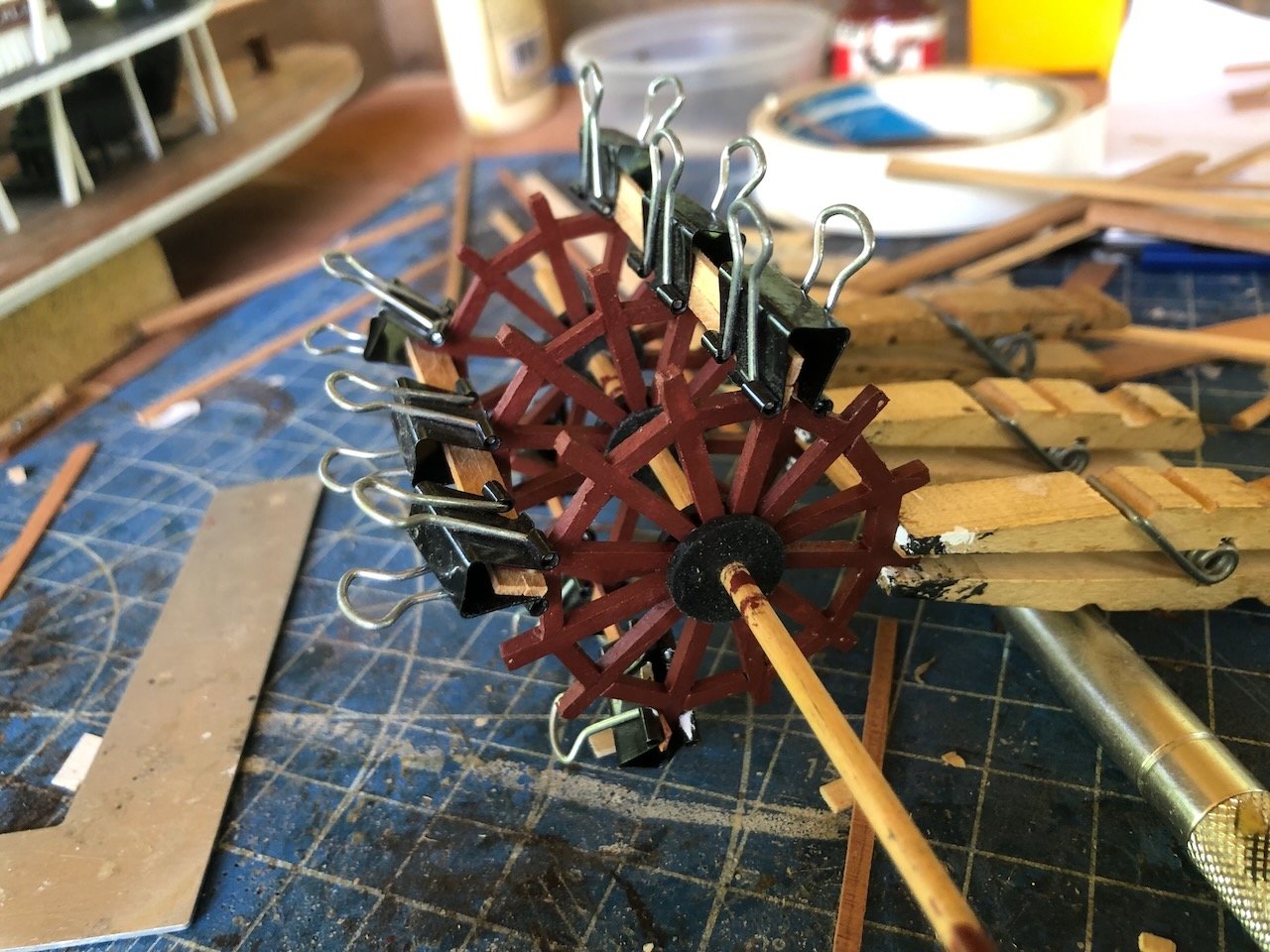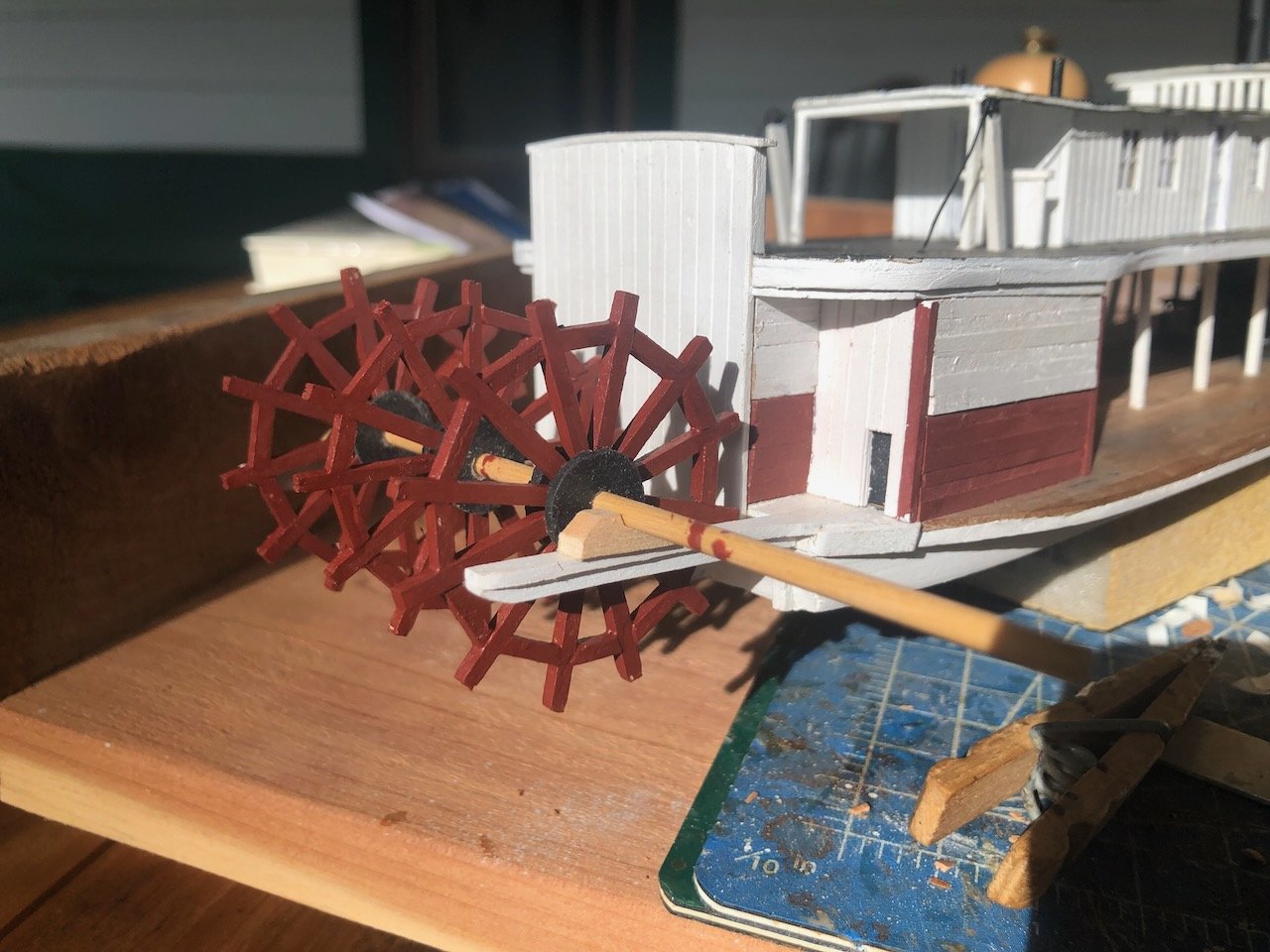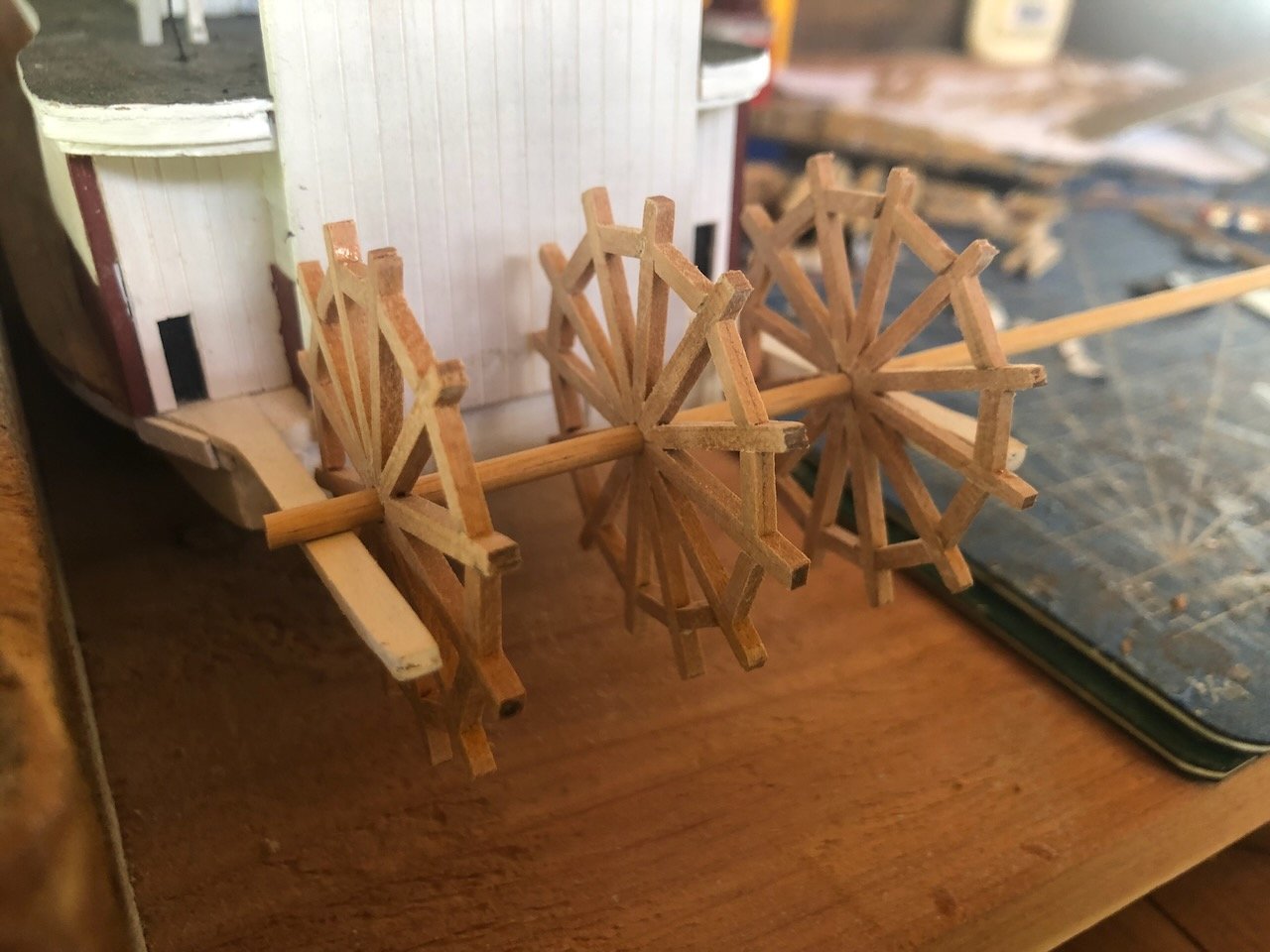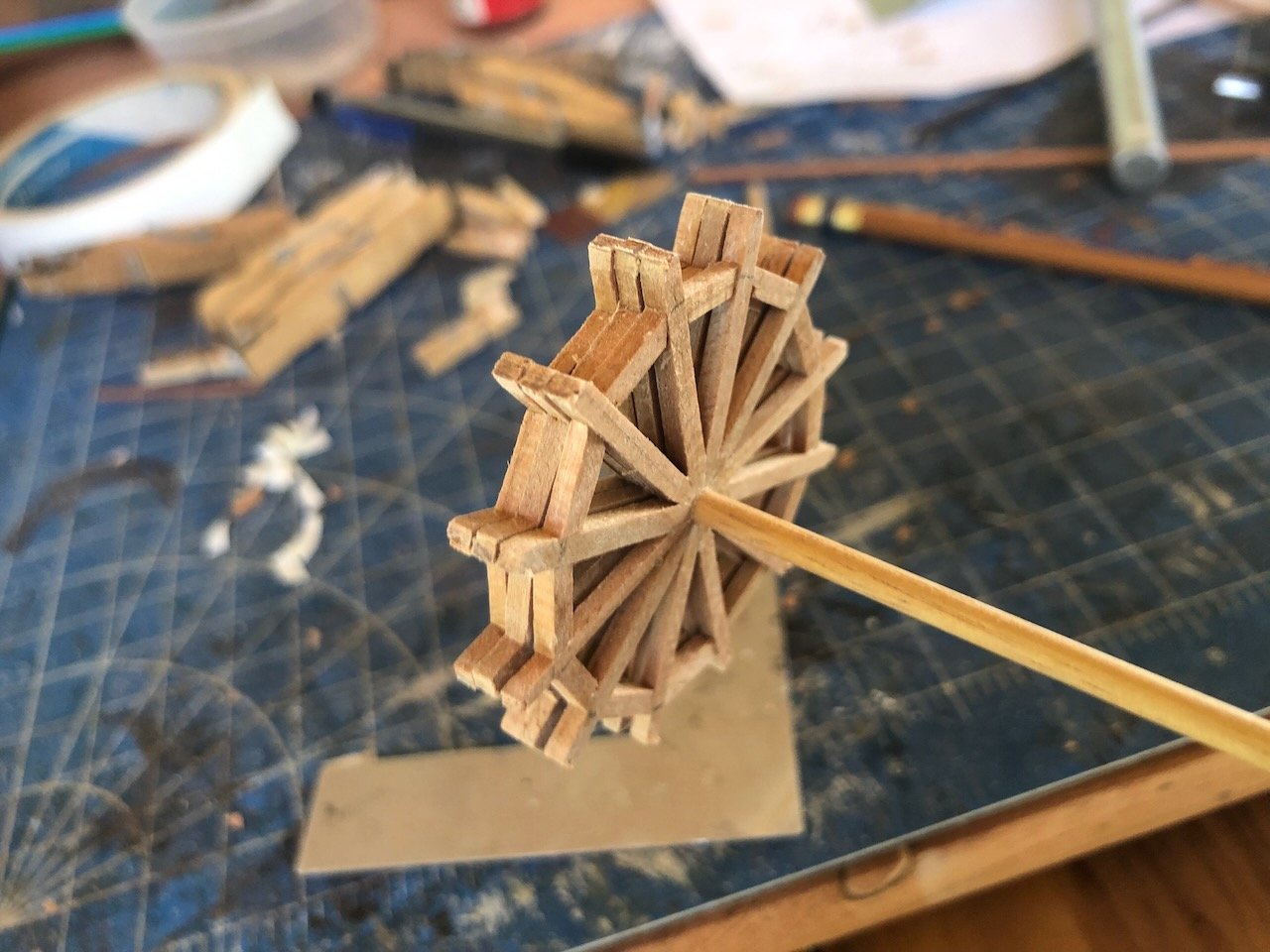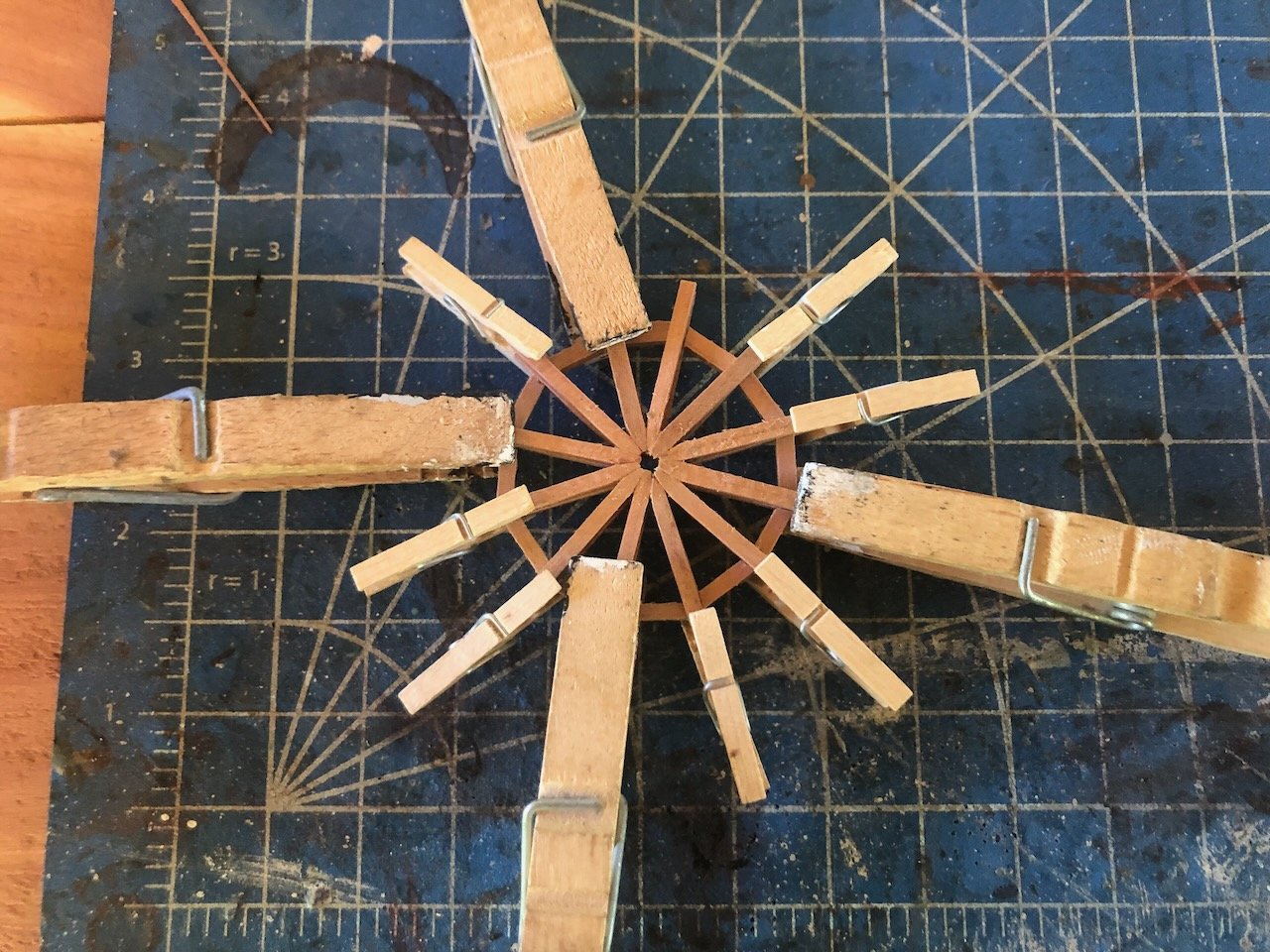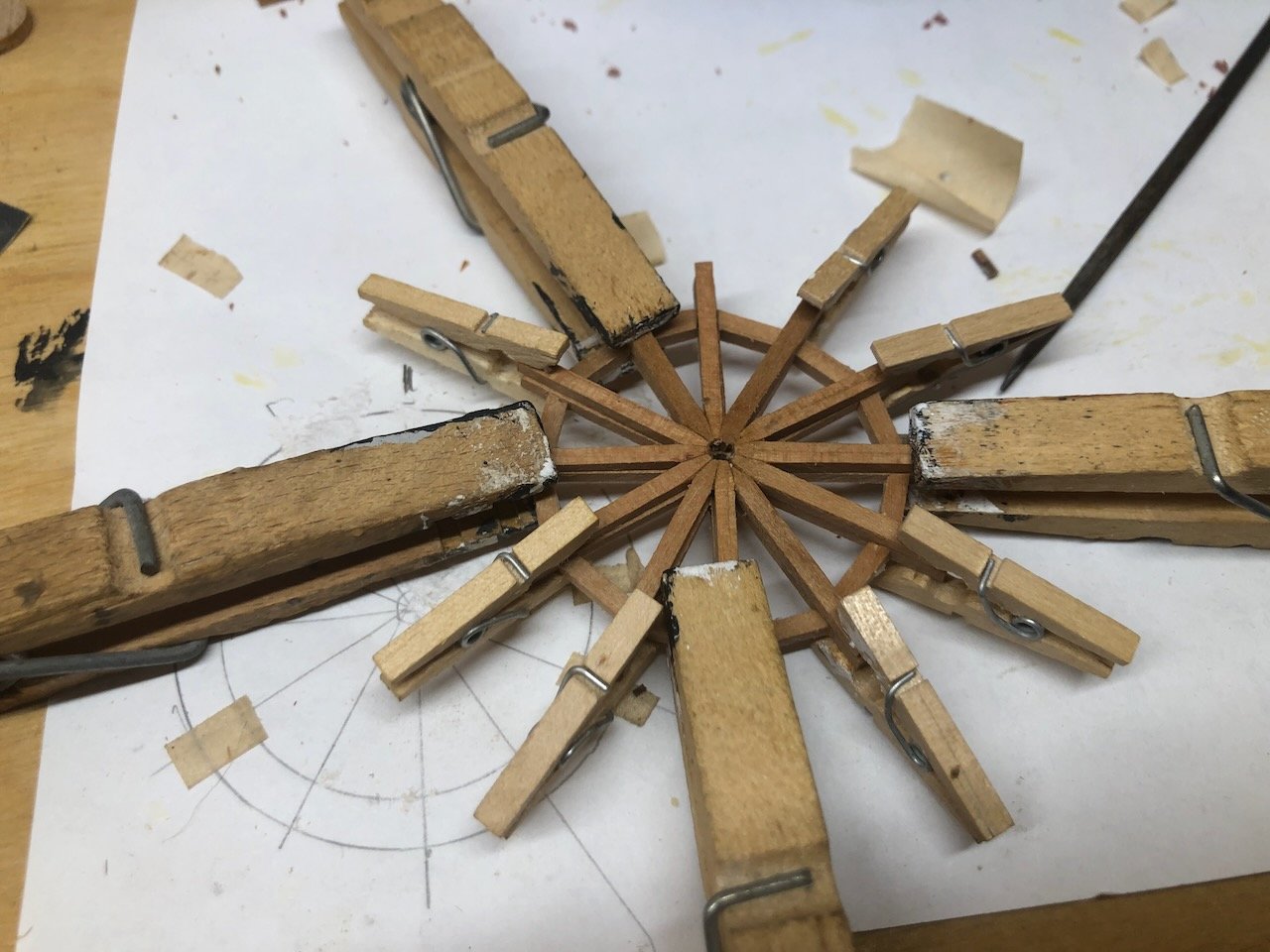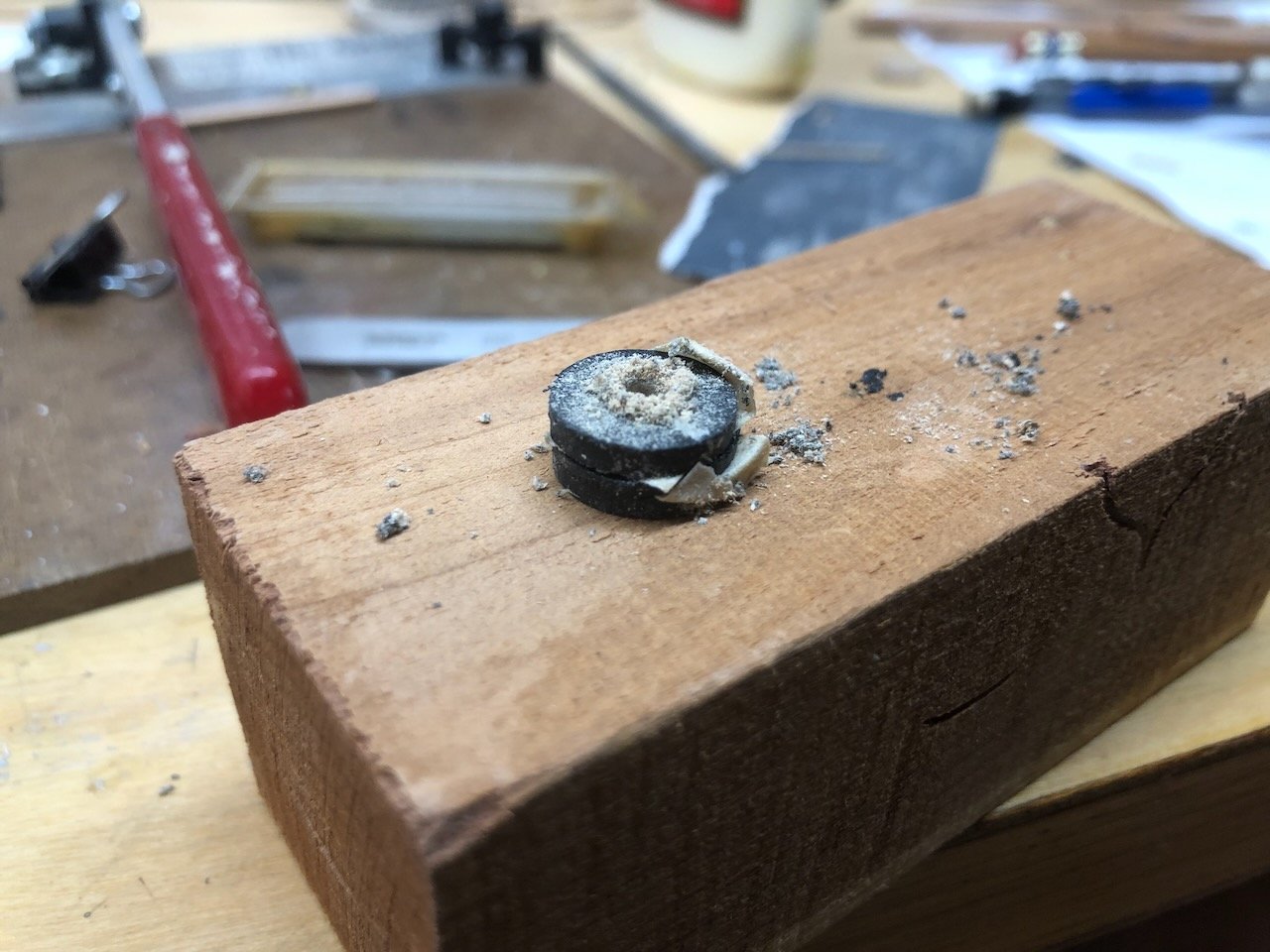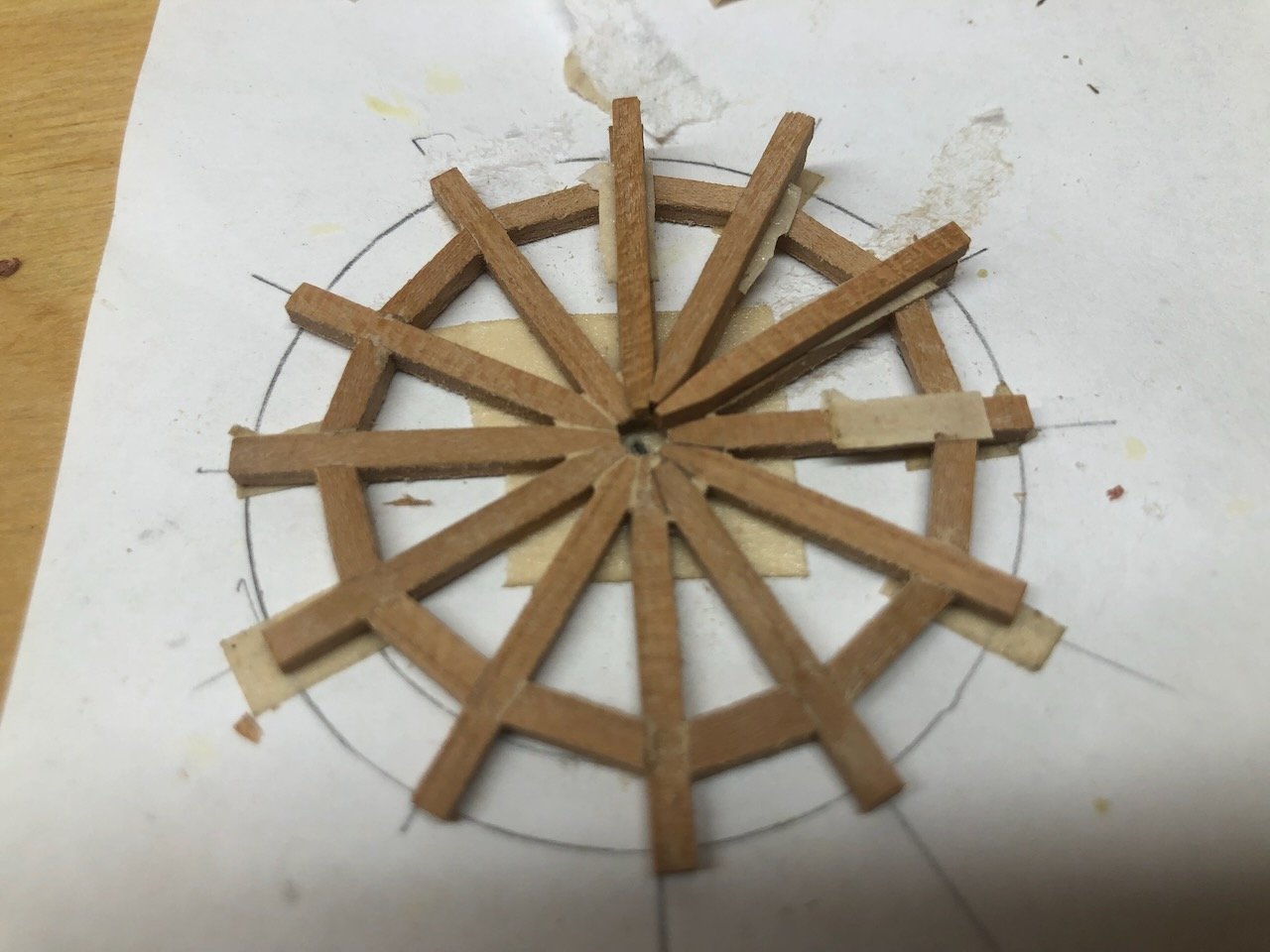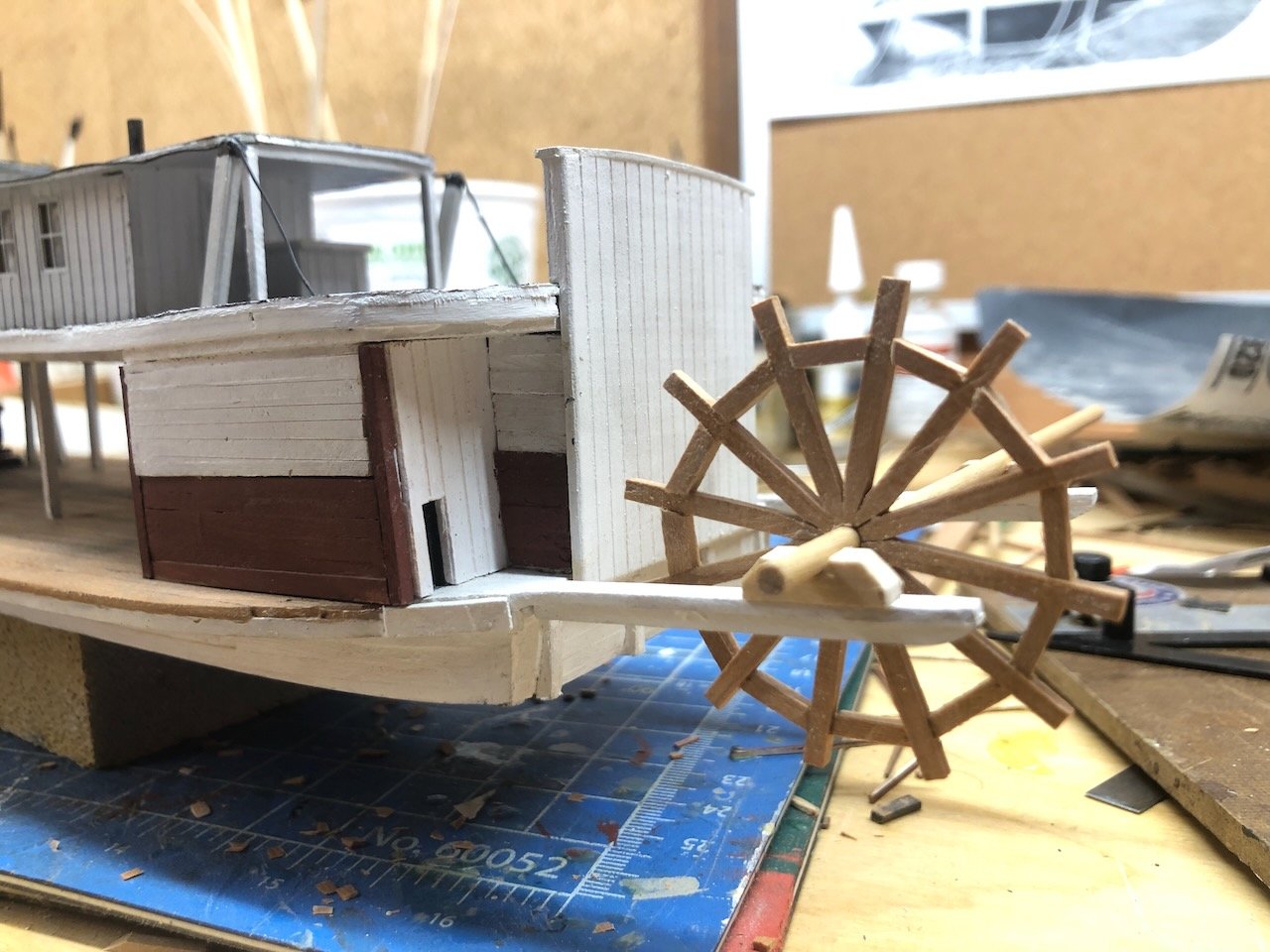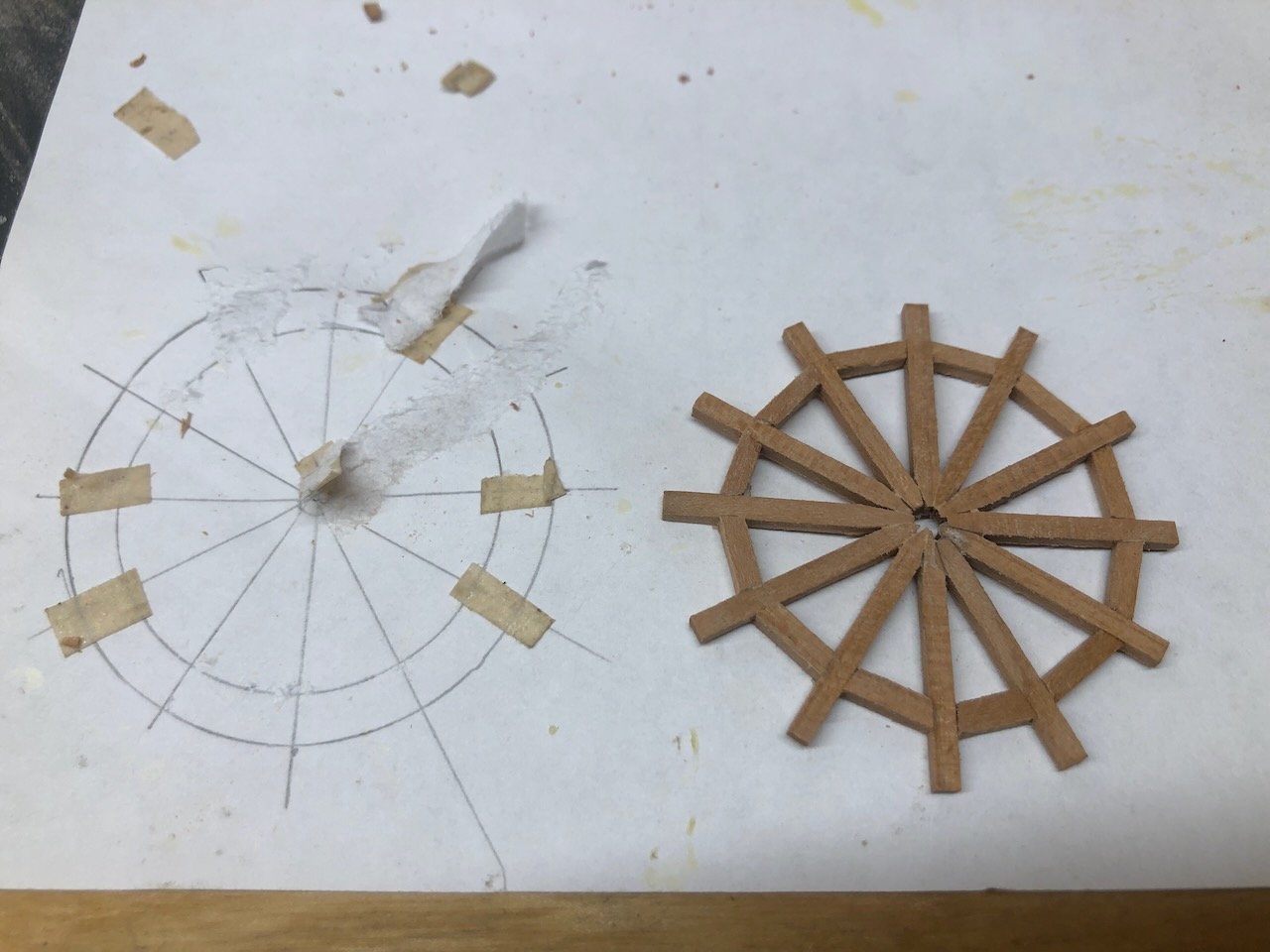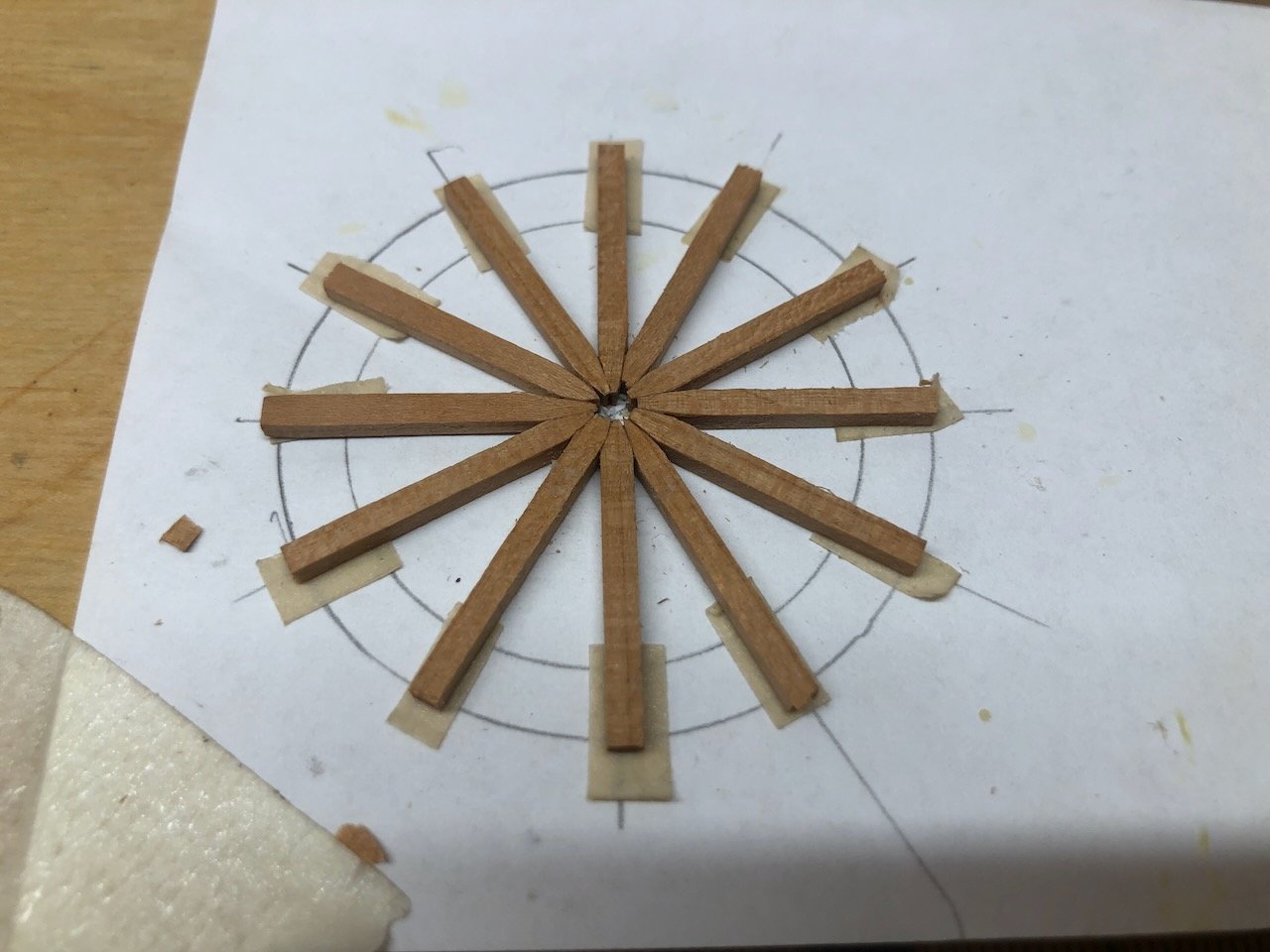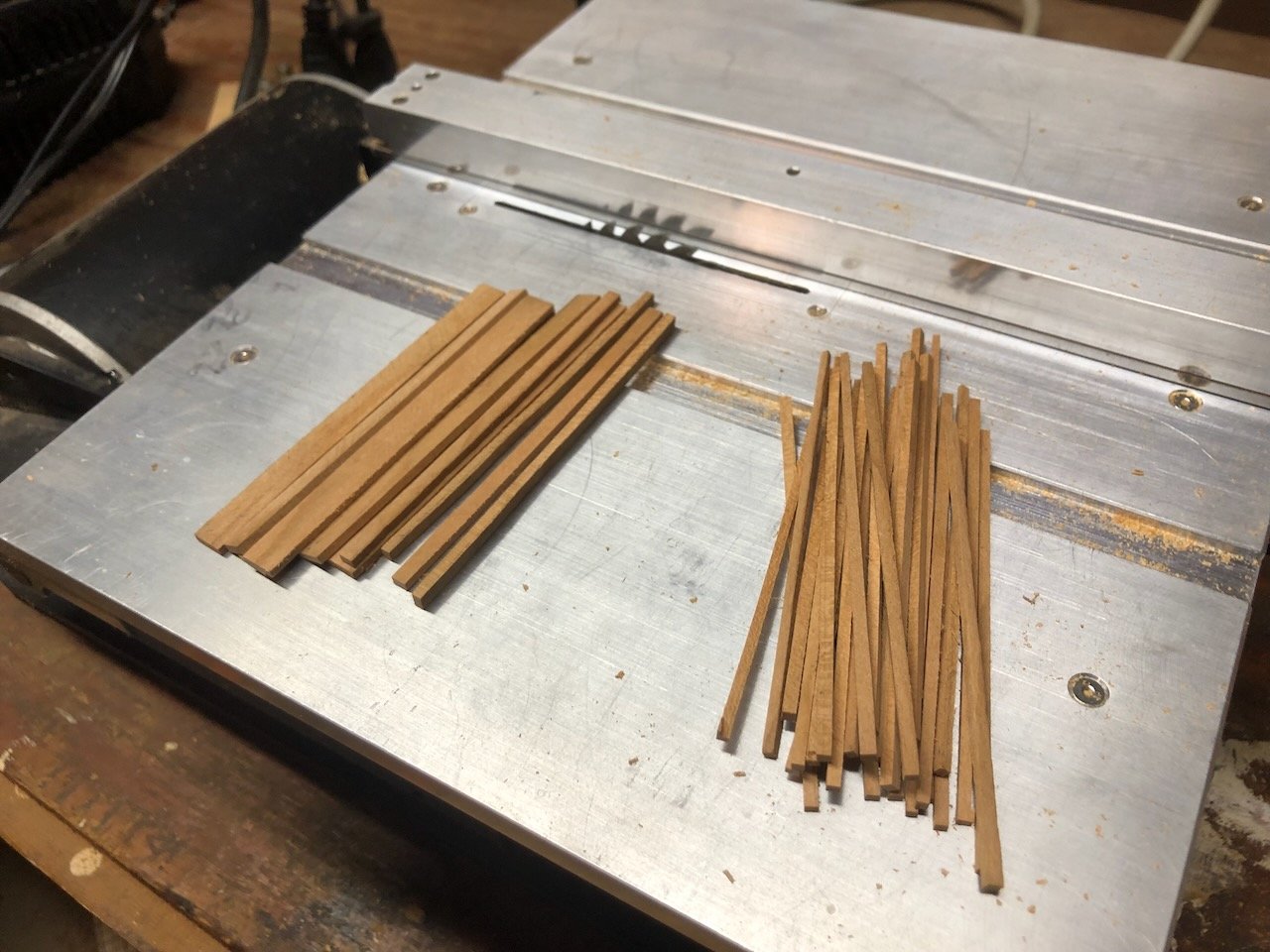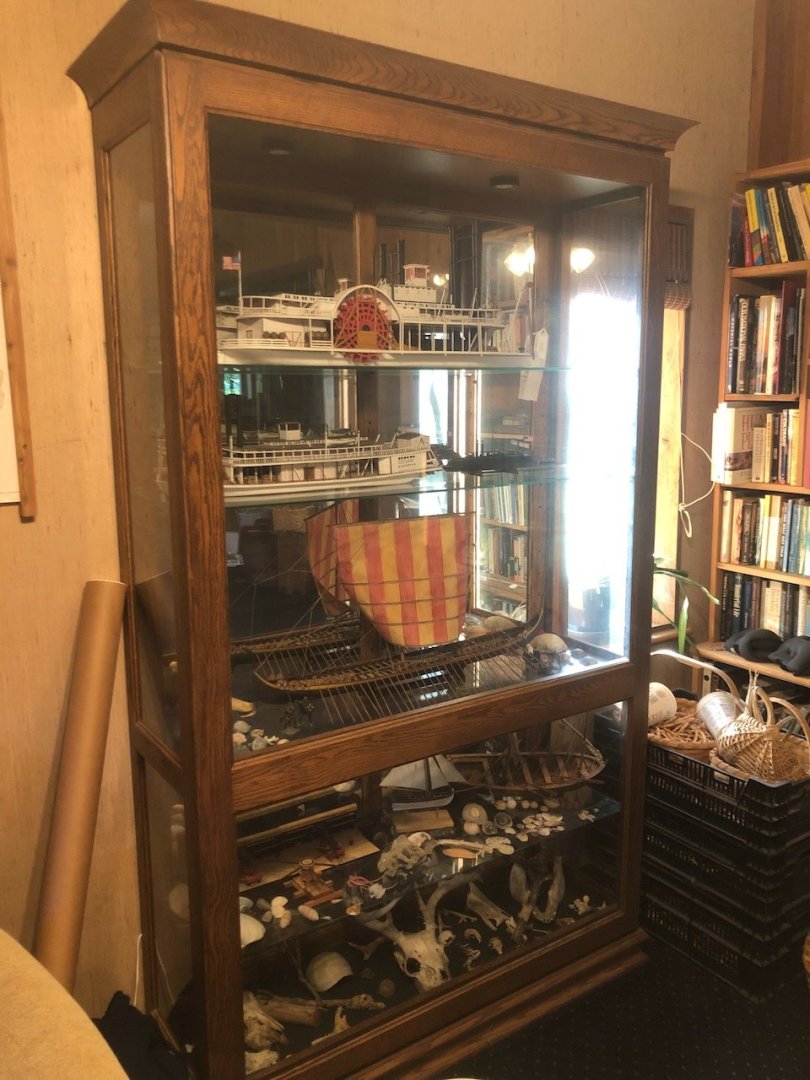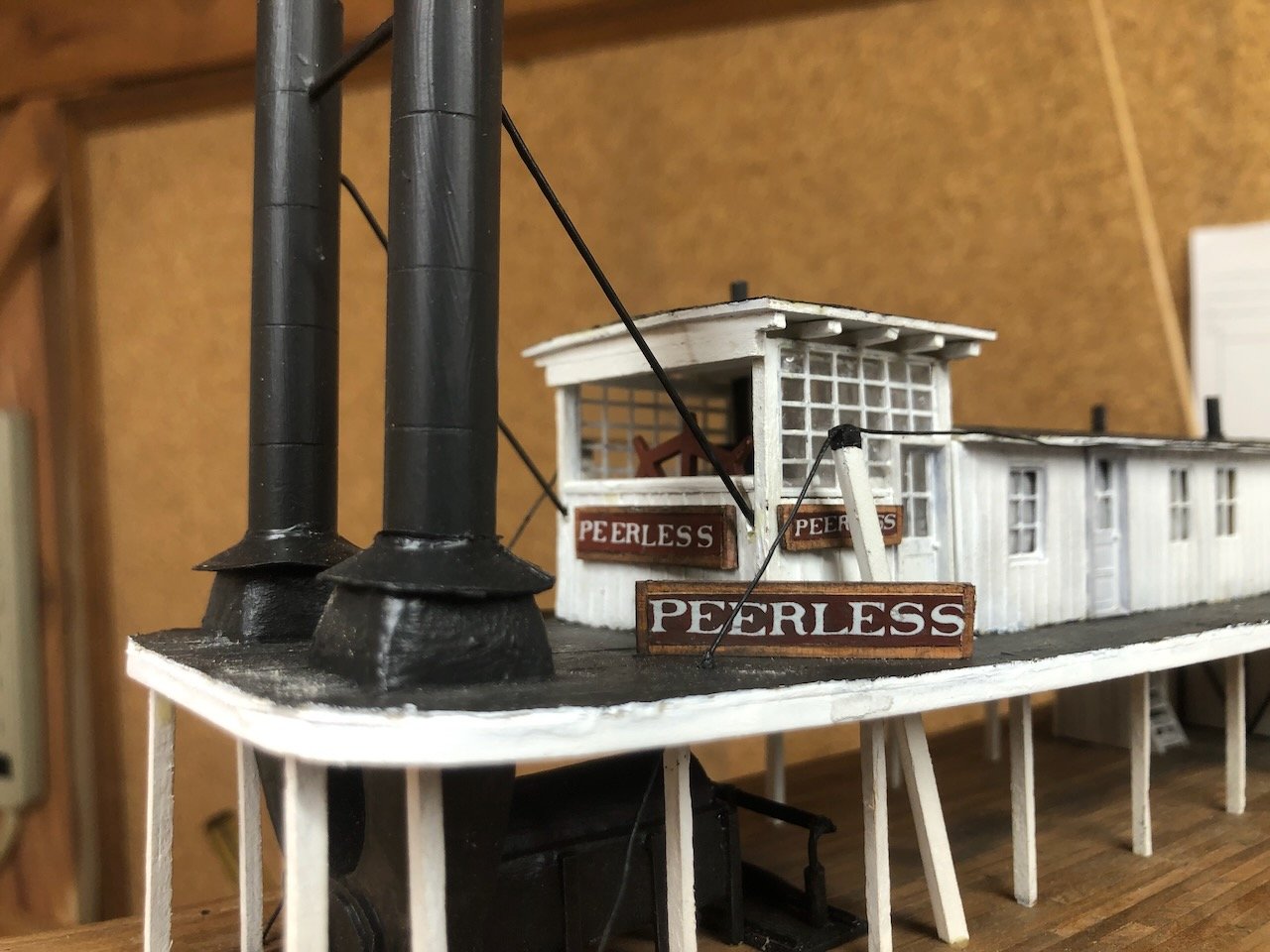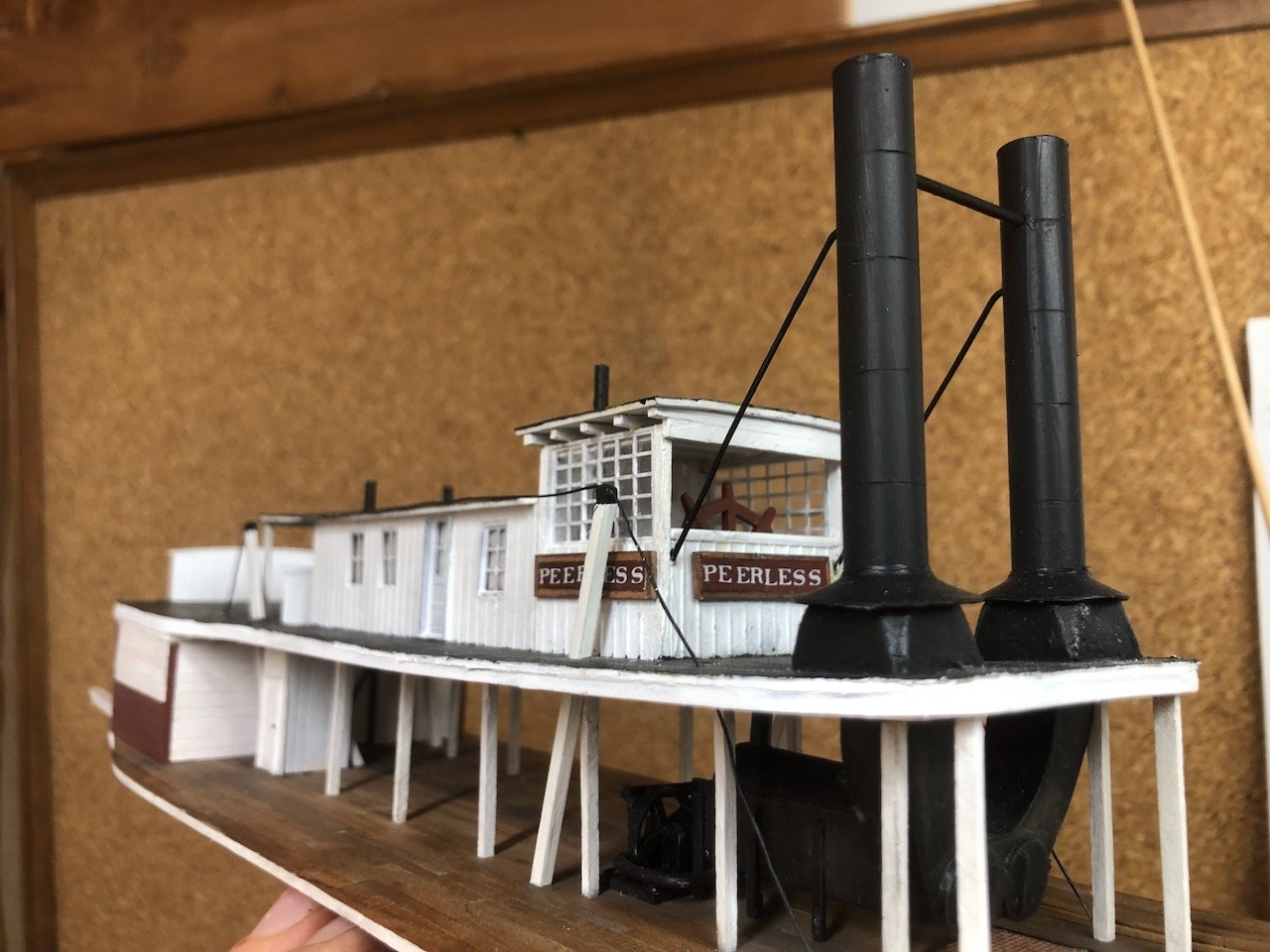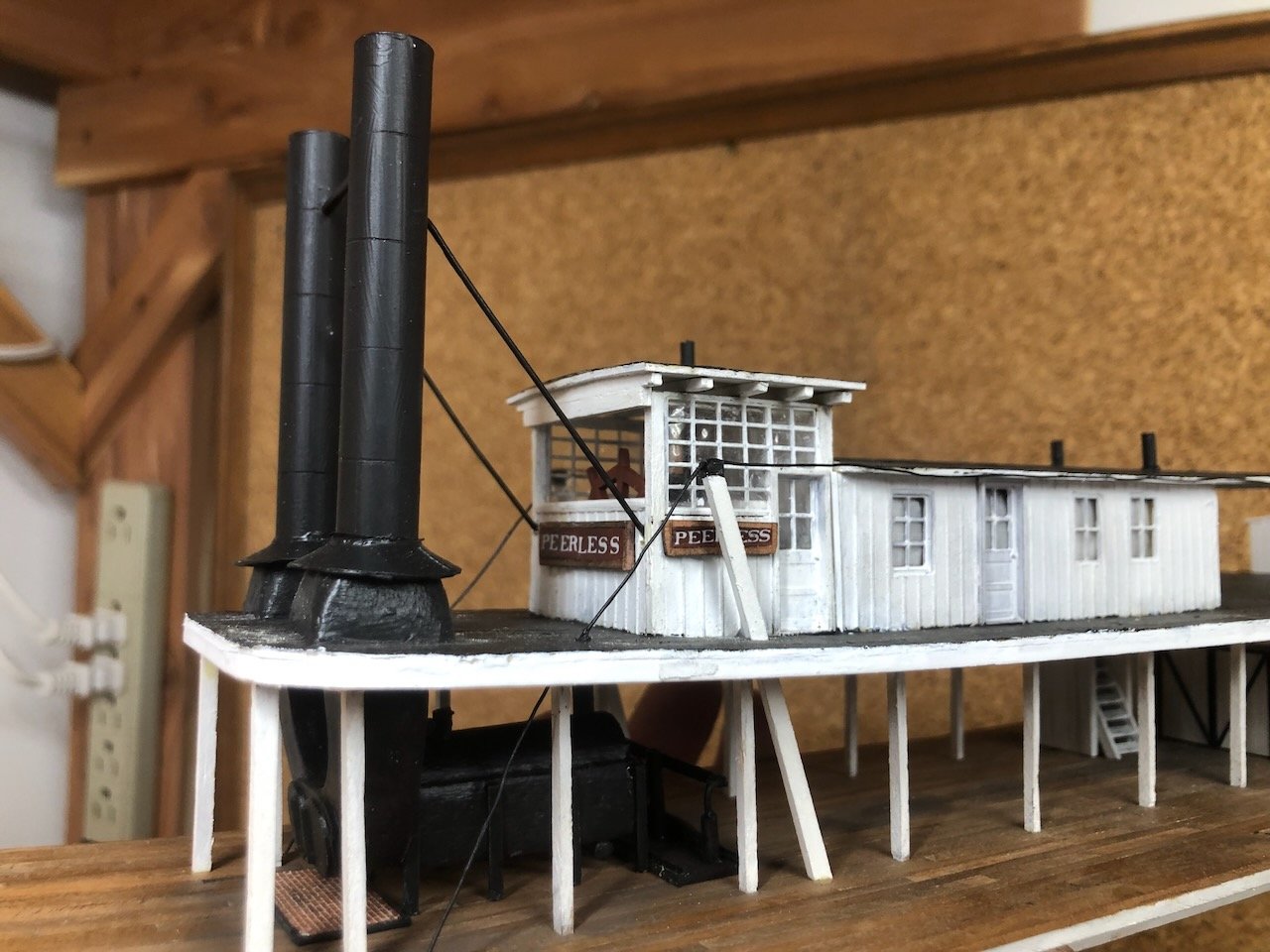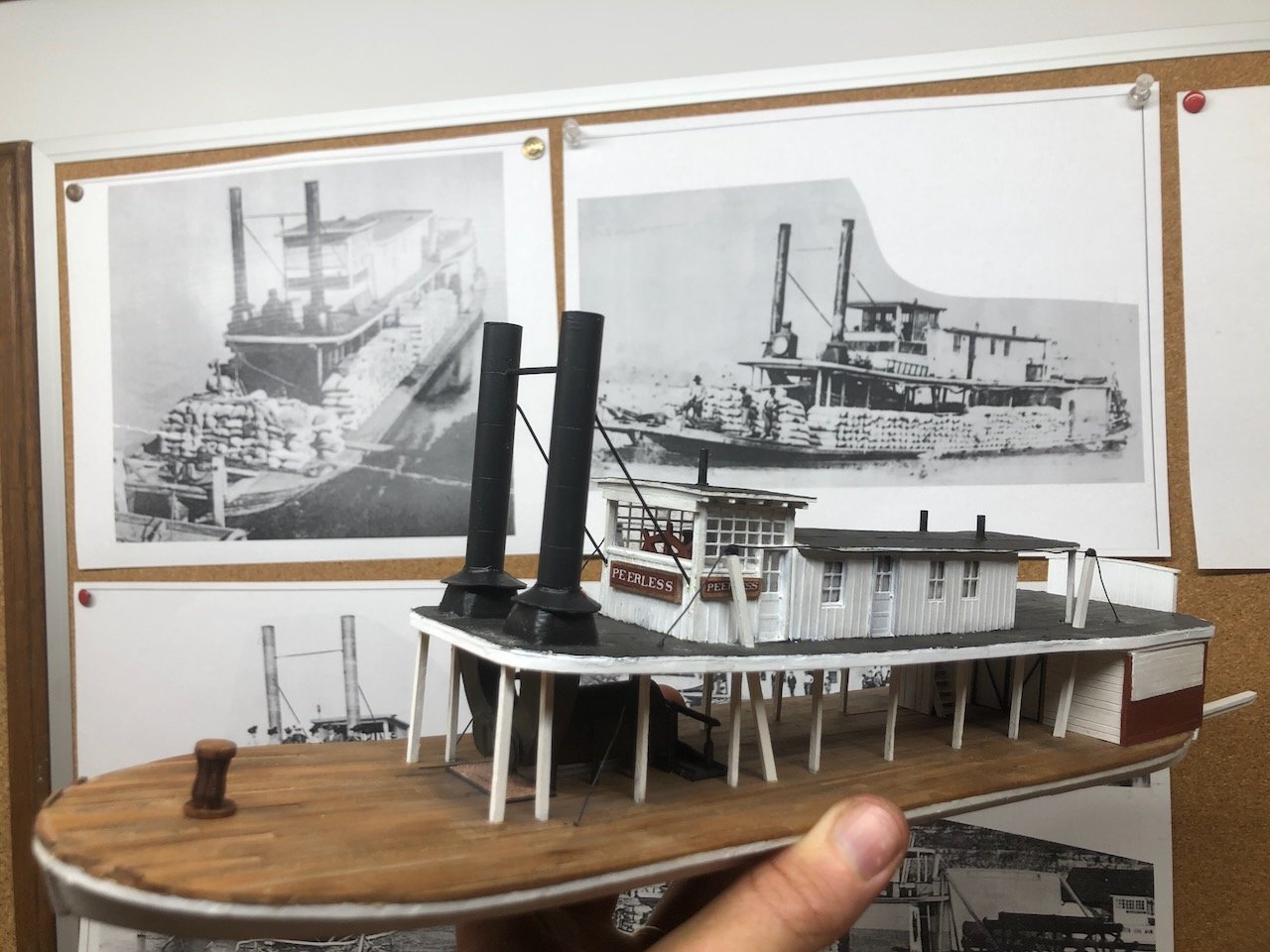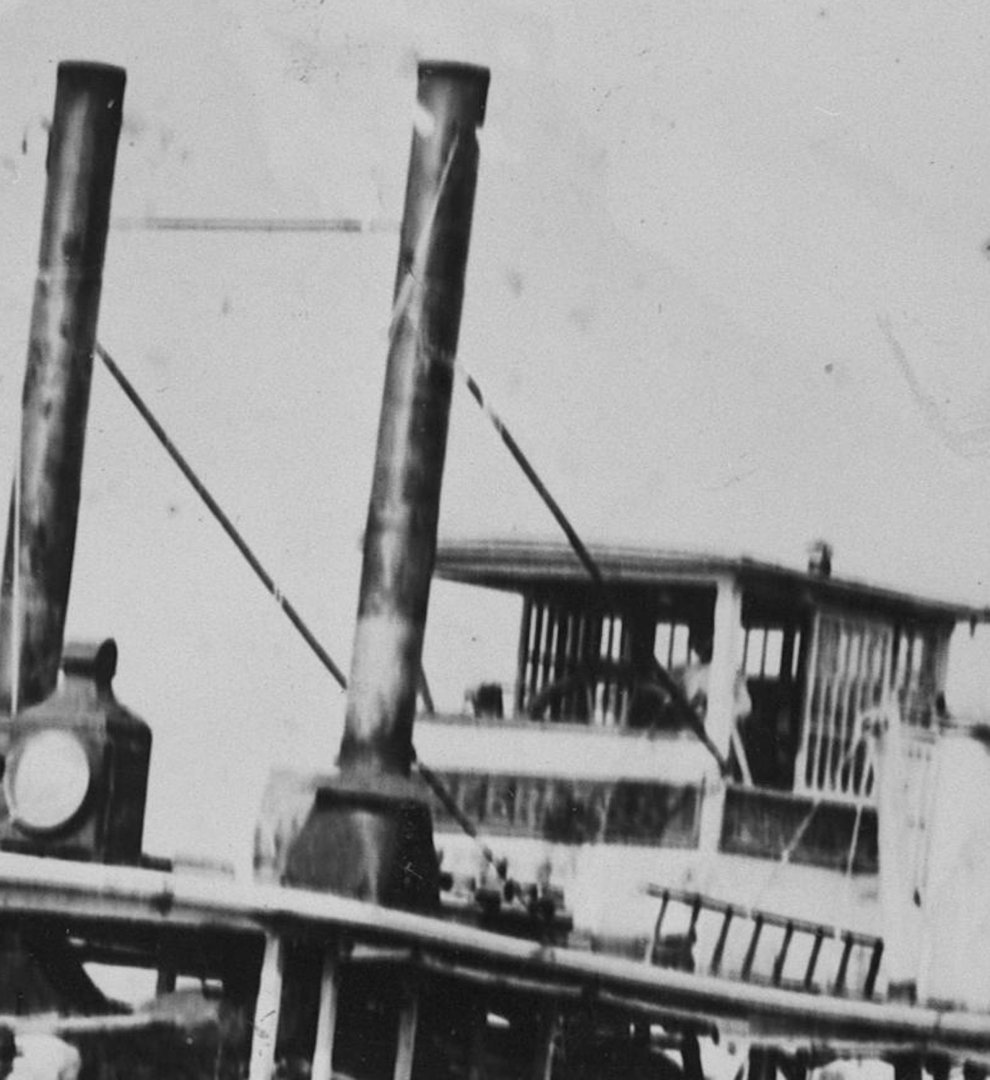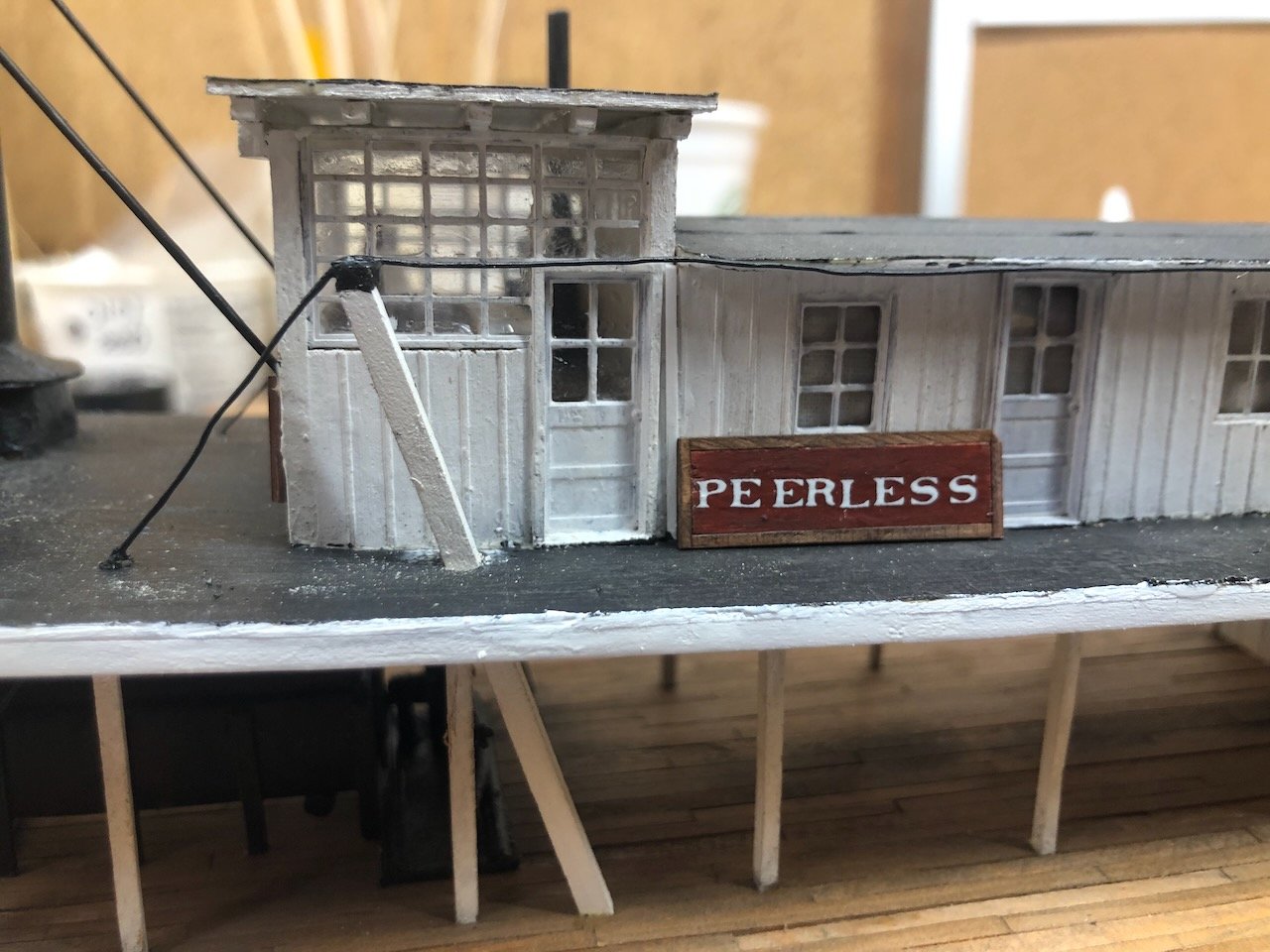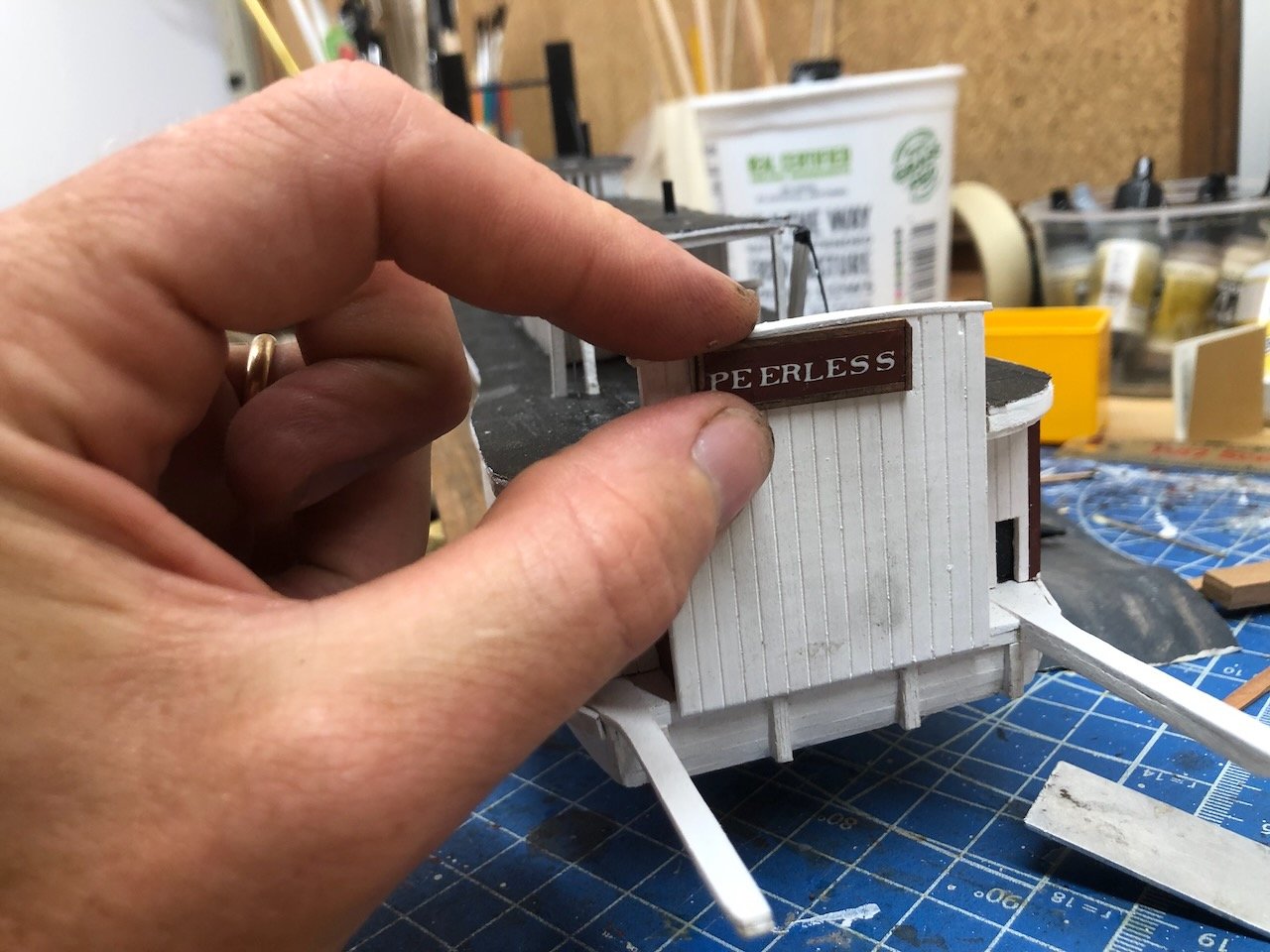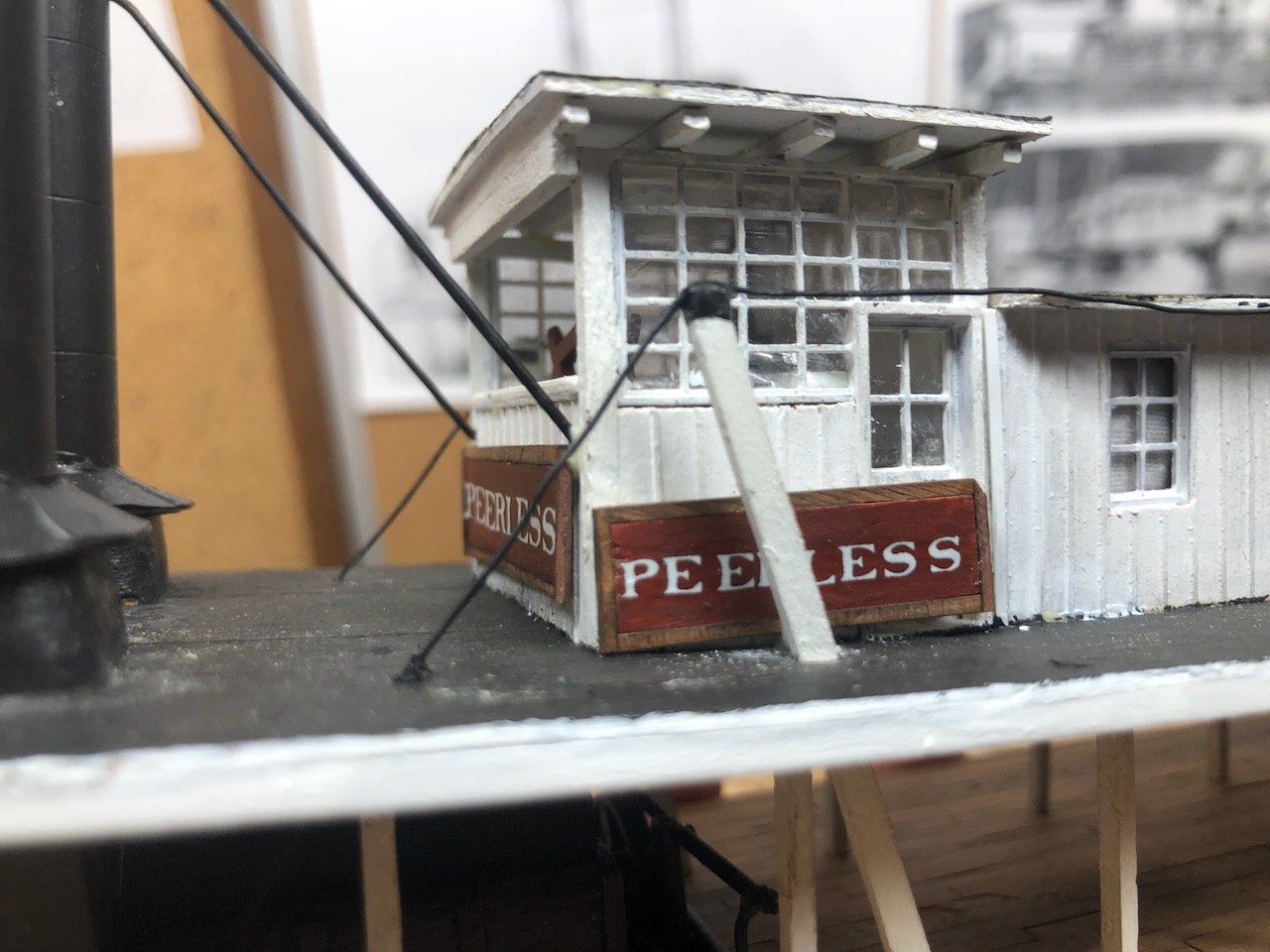-
Posts
3,479 -
Joined
-
Last visited
Content Type
Profiles
Forums
Gallery
Events
Everything posted by Cathead
-
Do you have access to a chainsaw? Arguably making a rough planar cut down one side of each section with a chainsaw would make it much easier to secure the rest of the section to a sled for further milling. Or you could do something similar with a bandsaw. Anything to get one planar edge that will sit flat (and could even be screwed to a sled from below) before you start running it through the table saw.
-
You've definitely got the right attitude for a wooden ship modeler! Flexibility, ingenuity, patience, and self-deprecation go a long way. As for applying pressure, many times one or more rubber bands can do a marvelous job where clamps or weights are difficult.
- 19 replies
-
- mississippi riverboat
- Mini Mamoli
-
(and 2 more)
Tagged with:
-
Paul, that's an adorable ugly duckling of a steamboat! Here's the link for those who want to see it: https://search.library.wisc.edu/digital/A73NDFPF5Q6HWG8M I definitely see the "patch" you mean and like the idea of seeing if I can come up with a version. That vessel also appears to use a pipe-shaped pitman arm. Thanks for calling that to my attention; it's even a Missouri vessel as it was built on the Meramec River near St. Louis and probably worked hauling rafts of logs. Just my type! EDIT: there's a model kit of Myrtle Corey! Who knew? https://www.harbormodels.com/dum1253.html Maybe this is a sign of aging (I'm only in my 40s!) but I swear I've made more mistakes on this build than any other, in terms of having to go back and redo things that in restrospect I don't know how I missed or got wrong. Feels like a constant theme in this build and I don't know why. Other than the excuse that off-model life has been particularly busy, stressful, and distracting through much of this build and my mental bandwidth probably isn't as focused as on some past builds. But it just feels annoyingly sloppy and may be driving some of you crazy!
- 393 replies
-
Wefalck, they were definitely timber on most boats; I suspect Peerless is different being so much later than the peak era. I may try your idea of a little thin "repair" cladding over the broader hole if I switch to a pipe-shaped rod. Brian, I had never run across that idea before so I don't know! Not a change I'm going to make, though
- 393 replies
-
Goodness, Keith, I seem to really have altered that area from the original without even really realizing it. Not only is the pitman arm hole much smaller (and rounder) than my version, as you say, but there's a whole open slot between the engine area and the main structure that I just plain left out. I went back and looked at that part of the log (page 4) and I think I might have mis-interpreted the historical image the first time, thinking that the larger floor-to-ceiling slot was where the pitman arms went through, and shrinking that down because the full-size opening would have been too awkward with my solid-block superstructure. In this framing I guess I just ignored the tiny round hole as unimportant. I don't really know what I was thinking because I didn't fully talk it through in the log. It's so obvious now! Why didn't any of you stop me??? I also now see what you mean about maybe the pitman arm being round? Like a piece of metal pipe instead of the more traditional wooden beam? I could probably rig up a version of that with a length of styrene tubing, maybe I'll play around with that. I'm definitely torn between trying to make some accuracy upgrades and just leaving it be as "my version".
- 393 replies
-
Funny thing about sawing and milling my own wood...it makes the material simultaneously more and less precious. Obviously a lot of work goes into that material compared to just buying a packet of wood from some retailer. On the other hand, at the scale of landscape management, I easily produce way more wood than I'll ever be able to use for modeling. A single firewood-sized chunk of maple still produces more wood than I'd use in a single model, much less a whole tree. So it doesn't matter how much I use (or waste) because there are multiple lifetimes of model wood sitting rough-milled in my barn that are a fraction of the broader wood use for firewood and cut as part of general forest management. Anyway, I pretty much finished the stern assemblage, shown here in this zoomed-in image: And here's my version: Let's back up. Harkening back to an earlier discussion on rudders, I made some rudimentary pieces that represent the tips of the rudders sticking out of the water. These will be mostly hidden by the wheel but I wanted them hiding back there: The bracing that helps support the weight of the wheels was pretty straightforward. On the real vessel, the forward support post appears to go through the boiler deck, but I didn't plan ahead well enough and wanted this to be strong, so I carved a notch into the aft edge of the deck instead. This lets the post be at a reasonably accurate angle but be fully braced against the superstructure instead of just loosely glued to the top of the boiler deck. The wheel is driven by two pitman arms that extend from the engines to either side of the wheel, connected by a sort of cam. I carved the latter from pieces of cherry, and drilled holes to accept small brass nails that would hold the assemblage together: Here I'm pushing one nail through the cam into a pre-drilled hole in the end of the axle; same on the other side. No glue, letting me position the cam as desired when I fit everything together: Then I cut two pitman arms from cherry and carved/sanded them to a shape I liked. At the forward end, these just butt up against the solid wood block of the "engine room", letting the dark paint pretend to be shadow. At the aft end, the nail in the narrow end of the cam goes into a hole predrilled in the arm. Here I'm testing the rough length of one arm: And the other side: Sharp eyes will notice that the pitman arms are cut to different lengths so that the port and starboard cams aren't in the same orientation. As I understand it, the arms were set to be 90º off from each other to allow proper functioning of the engines. Staggering them this way let each engine's stroke balance the other one out; if they were both set the same way, the whole system would stall as it tried to make a full rotation on one stroke. And here are a few views of the painted pitmans in place. These aren't glued, just set and pinned in place for the moment. This last shot clearly shows the offset pitman arms and cams: I initially painted them white as many steamboat photos I've seen seem to do that. But I then noticed that the historic photo zoomed in at the beginning of this post makes the arms look very dark, so I'm considering repainting these black. Thoughts? Once I'm set on the final color, I'll install these permanently and paint over the nail heads. Then I think the structure of the vessel is basically done, awaiting only detailing. In the meantime, as I write this, steady rain is developing outside as a moisture plume extending off ex-Hurricane Beryl makes its way into Missouri. Having had nearly 10" (25 cm) of rain in the last week, the soils here are fully saturated and any further rain could be truly problematic. The forecast models claim the storm track will go south of our location with only minor effects, but I'll believe that when I see it; they didn't predict the last 10" either. It's going to be a nervous night as we wonder whether we'll be flooded again by tomorrow. In any case, thanks for following along and giving me so much encouragement along the way. Pretty wild to see this almost done.
- 393 replies
-
Welcome to MSW! As a riverboat person myself, I'm glad to see your interest. I also agree that I much prefer working with wood over plastic, personally. I'm not familiar with this kit personally, but will be happy to provide broader guidance as needed. It's common that non-native-English kits have terrible instructions. If building this sparks your interest in going further, I'd strongly recommend trying Model Shipway's Chaperon steamboat, which is far more accurate, has far better instructions, and a supplementary guide written by an MSW member and riverboat expert. Kits like the one you're trying have an unfortunate tendency to turn people off on the hobby, so I hope you stick with it and enjoy the learning process!
- 19 replies
-
- mississippi riverboat
- Mini Mamoli
-
(and 2 more)
Tagged with:
-
Don't get ahead of yourself, I said we had A day of unusually nice weather. It won't last, we'll be back up into our normally hot and humid conditions by next weekend. Just prior to this briefly pleasant weekend, we suffered through a stretch where we received almost 9" of rain in three days, causing a wide variety of damage. Generally speaking, you do NOT want to visit here from mid June through early September if you're remotely adjusted to a British climate.
- 393 replies
-
Nah, to each his own. I finally had a relatively quiet weekend here and got quite a bit done! We had absurdly beautiful weather for this time of year, so I got out my portable work station and took the model up to our screened in porch so I could enjoy fresh air, natural light, and birds while working on the model. For the buckets, I cut some strips of on-farm maple the full needed width, then split them with a knife to make two planks. This looks better visually and milling the thinner strips would have wasted a lot more wood from the saw's kerf. I then marked the proper orientation for each wheel (to ensure all three matched), then started slowly gluing pairs of bucket planks on. I also spent time carefully measuring and marking where to cut off the bottom of the wheel. Here's the final product, with the bottom-most spoke cut off entirely and one on either side cut down partly (including their buckets). The raw maple is visually very attractive but it needed to be painted for accuracy, so I did. In the meantime I'd made and painted two housings to hold the axle, then glued them in place. Here's the current state of the build, with the wheel on its housing (though the axle is still removable and not yet painted). I also glued on the forward timbers. The light's a little wonky but you get the idea. I'll take better shots soon. Next up is to develop the bracing that supports the wheel housings, and the driver arms for the pistons. I think those are the last structural details. I have some detail parts on order and that'll just about complete her at this time. The end is near! Thanks as always...
- 393 replies
-
There's a clear argument for going that direction, but I currently have no interest in 3D printing. I enjoy working with my hands, using mostly natural materials. I spend enough time on a computer professionally that about the last thing I want to do in this hobby is spend more time staring at a screen doing computer design! Obviously there are arbitrary limits on where any of us draw the line; I won't be hand-carving any 19th century figurines from hand-milled wood. I just find, personally and without broader judgement, that 3D printing takes the hobby in a direction I don't really want to go personally, though I'll almost certainly take advantage of certain products like figures or detail parts that may well use the technology. But I don't want to use it myself.
- 393 replies
-
Ras, happy to provide inspiration! I used a similar method on my other steamboats and it's become a comfortable approach for me. This time, as you'll see below, I only used one pattern and built successive wheels on the first one. Another approach would be to computer-design a pattern and print out a whole series so that each wheel can be assembled on its own pattern, I think I did it that way before too. Here's some more weekend progress. I built the other two wheels directly over the first one, to ensure that they all matched. I'd rather have them all consistently eccentric than near-perfect but not matching. So I laid small strips of double-sided tape on the first wheel, then started hand-cutting and shaping each spoke to fit: When they were all shaped, I glued the assembly together and used clamps to ensure it stayed parallel to the first pattern wheel while the glue dried. One thing to be careful of here is not to let glue squeeze out below such that the two wheels get glued together right at the hub where it's hard to get to. I tried to avoid this but it happened slightly; I was able to separate them with a thin knife. It would probably have made sense to put a thin piece of tape or other masking at the hub area to avoid this. But it worked out fine. I then marked the locations for the spacers and slowly assembled those, too. The end result was three wheels that match pretty nicely for hand-made assemblages. At this point I also trimmed all the ends to be reasonably consistent in length. I wanted some "hubs" to help bind these together, so cut a stack of thin discs from a dowel, painted them black, stacked them together with strips of double-sided tape, and drilled down the middle to create a consistent axle hole: Then I painted the wheels and assembled each one with a hub on each side. Here they are threaded on an axle for show, but not in any final orientation: Next up will be working on the "buckets", the proper name for the horizontal slats that actually grab the water. It's nice to feel like I'm making some regular progress again. Thanks for reading!
- 393 replies
-
Nice progress, good to see you're still working on this.
- 157 replies
-
- chaperon
- Model Shipways
-
(and 1 more)
Tagged with:
-
Well, I quietly missed the one-year anniversary of this build, but I have made some progress by starting on the final "big" project, the paddle wheel. First I cut a whole stack of cherry lumber (same as that used for the main deck) on my Byrnes saw. This is more of the material I harvested here on-farm. Then I laid out a pattern by estimating the size I wanted the wheel to be, from the one decent photo I have, and fiddling with different round objects until I found two diameters that were close enough. Once this was drawn, I set down tiny patches of double-sided tape on each leg's location and began laying out the wheel: Each leg is hand-tapered to fit its neighbors using a sharp knife and sandpaper. I didn't worry about the exact outer length as I'll trim them all down later. I was most concerned with a consistent inner pattern and leaving a clean hole for an axle at the center. When I had them all dry-fit to my satisfaction, I removed each one, put a dab of wood glue on its inner surfaces, then re-assembled the wheel and let it dry. Once this was solid I began hand-cutting the outer circle, formed from a series of small wedges custom-fit between each leg. This is all slow, fiddly work that goes well with a baseball game on the radio. Here's the final result: And here it is test-fit on the vessel: As previously discussed I'll be cutting off a small portion at the waterline but intend to do that once I have all three rings made and can be certain I do them all consistently in the right place. I think it's easier to build the whole wheel and cut it down than try to guess ahead of time exactly where I want the cutoff to be. Overall I think it looks pretty good! Thanks, as always, for the kind comments and support.
- 393 replies
-
Hey Keith, I have a hard time hitting "like" on your last post as I know it's sharing a deeply emotional situation for you, but just wanted you to know I hear your pain. We, too, have had our life path altered by the responsibility of caretaking, though not in the same way as you, and it just is what it is. Hope you can keep your head up and recognize the love involved in the choices you're making. Take care of yourself.
-
Ras, I finally got around to checking out your build, after seeing you following my own. What a fantastic project! I'd never seen a steamer like this before and it really is a unique vessel, perfect for a memorable scratch build. I'm especially impressed by your metal work, as that seems like magic to me who has never done it. Keep up the good work and I'll be following attentively from now on.
- 128 replies
-
- zulu
- sternwheeler
-
(and 1 more)
Tagged with:
-
Here's a rough shot of my large display cabinet. Holds three very large models on top, with an assortment of smaller ones on the lower shelves, along with shells, rocks, bones, antlers, and so on. All on the footprint of a single-model case and with a sliding door that seals reasonably well against dust. The mirror in back is a nice touch that lets you see the far side of models. Had this made by a local Mennonite shop for a reasonable price given its quality and usefulness.
- 90 replies
-
As someone who inexplicably enjoys painting figures, those look wonderful! And you're sharing so many neat learning experiences with us that make this a joy to follow. Thanks for brightening all our days even when yours have been darker.
-
Keith, I came to the same conclusion, that I had made the signs too high. That still doesn't fix the text spacing problem, because it still relates to how those eight letters fit within different lengths. But it was definitely part of the problem, so thanks for the extra nudge to go that direction. So I went back and cut down all three signs I had made, and redid their borders. I then took a gamble and made a fourth, very small, sign that would fit along the port side of the pilot house, and was juuuuust wide enough to fit in the eight letters with the smallest font provided on my sheet of dry transfers. These actually came out quite well, so I decided to not use the biggest sign, shift the two medium signs to front and starboard, and use the little sign on the port side. Here's what they all look like together (the former front sign just propped in front for reference): This doesn't quite match the photos because the port sign is shorter than the front sign, but I'm ok with that because I think the tight spacing between text and top/bottom border looks better than text floating in a larger margin. I just think the tight signs look better, as Keith suggested. And here are two more shots of the new approach from both sides. You'd better like them because I glued them on! I feel like these really add some flair and personality to the model. So here's one more broader view against a backdrop of original photos. Close eyes might notice that the tow knees are missing. I'm leaving them off while I work on the paddle wheel because I'm afraid of knocking the bow against something while I'm focused on the other end of the model. They're easy enough to attach as a final detail. Thanks as always for the likes, comments, and nudges to keep improving on my initial instincts. It's now clear there's no way I'm completing this in one year, but whatever. She'll be done when she's done.
- 393 replies
-
Brian, that's a really creative idea, but I think when you look at the zoomed-in image I posted above, to me it looks like the door is clearly white all the way down. The hog chain post partly blocks the view, but the dark sign is clearly there left of the post but to its right there's nothing but a white door. Ras, thanks, but I do want to keep thinking it through because it just bugs me to have no nameplate sign on the port side of the pilot house. Especially because that's the intended "display" side.
- 393 replies
-
Ian, if you go back to the photo of all three together, you can see that I did use smaller font on my side boards but it still takes up too much horizontal space. The hints of lettering I can see implies that the side board lettering is just a little smaller vertically than the front board lettering, but must be painted on with a narrow font to squeeze the word in there. That's what I can't find a clear photo of; what that word looks like fit into that space. I had an idea overnight and will see if I can find time today to play with it. Thanks to all for helping me think this through; even rejected ideas help nudge cognition along.
- 393 replies
-
Here's a couple ideas on cases. One, there seem to be relatively affordable acrylic case makers out there. I bookmarked this one from a different MSW discussion and can't vouch for it directly: https://www.acrylicjob.com/product/custom-display-case/ Also, depending on how many models you intend to build, a larger cabinet could end up more cost-effective. Often called "curio cabinets", a lot of furniture makers offer these for people who collect dishes, dolls, what have you, and they can be adapted to ship models. They're not cheap up front, but mine holds at least 6 models, which on a unit-by-unit basis is quite cost-effective compared to 6 separate cases. It also takes up a LOT less space in a house than 6 separate cases since they're all "stacked" in one small footprint. Plus, you can share these with another family member; several shelves in ours also display natural items like shells, bones, etc. that we've collected.
- 90 replies
-
Mark, the photo I posted at the beginning of this update shows the port-side board, which is the same height as the others. You just can't read the lettering. Here's another image that I zoomed in and cropped, to clearly show the full-size lettering I based on my signs on, and that again you can't see just what's going on with that port side board. Maybe they used a more squished-together font there, but I can't easily duplicate that with dry transfers. I could print out signs to fit, but I don't like the look of that as well.
- 393 replies
-
John, if I used the small font (necessary for the port side) on the other two signs, it'd be dwarfed by the size of the signs overall, and they're very clearly that size in the historic photos. In another photo you can clearly see large PEERLESS lettering on the front, for example, filling that signboard. Plus, I'm thinking I'm not real comfortable laying out dry transfer text any smaller!
- 393 replies
-
Making a little progress on a rare quiet/unscheduled afternoon. Got a baseball game on the radio and taking care of a fiddly detail: the name boards on the pilothouse. You can see these here: I built these from flat scrap wood with borders of cherry that I carefully carved down with a hobby knife. The central panels are painted red while the borders are cherry darkened with pastel. I then used dry-transfer lettering to lay out the name. I really like the visual effect of dry transfers but have always struggled to lay out series of letters evenly. In this case I like the unevenness, as it yet again looks like some small riverside yard's best shot with a handmade stencil. And it's another one of those details that will blend into the overall rough-around-the-edges effect of the model's style. I made one larger one for the front of the pilot house and two smaller ones for the sides. Here's the front and starboard ones installed: But then I discovered something I hadn't thought through: the port side wall is shorter because of the pilot house door. The original photo shows a board there but I hadn't thought about how it actually fit into the smaller space available. It's the same size board as the other side, but has less length, so how did the lettering work? None of the original photos are clear enough for me to tell. So I clearly can't install this there. Two other possibilities: I could hang it off the stern or off the port wall, where it fits perfectly just aft of the pilot house: Or I could start over and make a new board of the correct length, but with much smaller lettering. That option feels wrong because I think the tiny lettering needed to fit in that space would just look weird. Thoughts?
- 393 replies
About us
Modelshipworld - Advancing Ship Modeling through Research
SSL Secured
Your security is important for us so this Website is SSL-Secured
NRG Mailing Address
Nautical Research Guild
237 South Lincoln Street
Westmont IL, 60559-1917
Model Ship World ® and the MSW logo are Registered Trademarks, and belong to the Nautical Research Guild (United States Patent and Trademark Office: No. 6,929,264 & No. 6,929,274, registered Dec. 20, 2022)
Helpful Links
About the NRG
If you enjoy building ship models that are historically accurate as well as beautiful, then The Nautical Research Guild (NRG) is just right for you.
The Guild is a non-profit educational organization whose mission is to “Advance Ship Modeling Through Research”. We provide support to our members in their efforts to raise the quality of their model ships.
The Nautical Research Guild has published our world-renowned quarterly magazine, The Nautical Research Journal, since 1955. The pages of the Journal are full of articles by accomplished ship modelers who show you how they create those exquisite details on their models, and by maritime historians who show you the correct details to build. The Journal is available in both print and digital editions. Go to the NRG web site (www.thenrg.org) to download a complimentary digital copy of the Journal. The NRG also publishes plan sets, books and compilations of back issues of the Journal and the former Ships in Scale and Model Ship Builder magazines.




